PBE Europe as Axell Wireless DFR-LTE-3380 DR3307 700MHz Booster User Manual Manual
Axell Wireless DR3307 700MHz Booster Manual
Manual
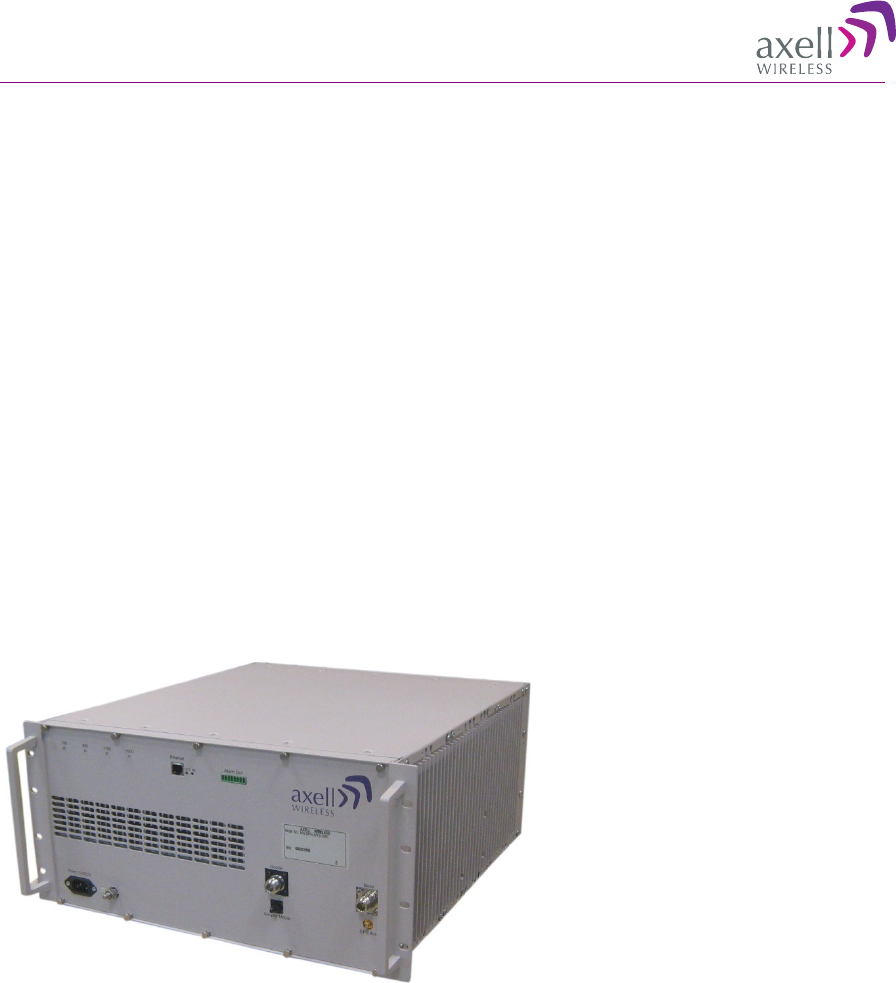
A
XELL
D-MBR-USA-USA
R
EPEATER
PRODUCT DESCRIPTION AND USER’S MANUAL
High Selectivity Digital Multi-Band Repeater
Product Description and User’s Manual
for Axell D-MBR-USA
700LTE/850CELL/1700AWS/1900PCS
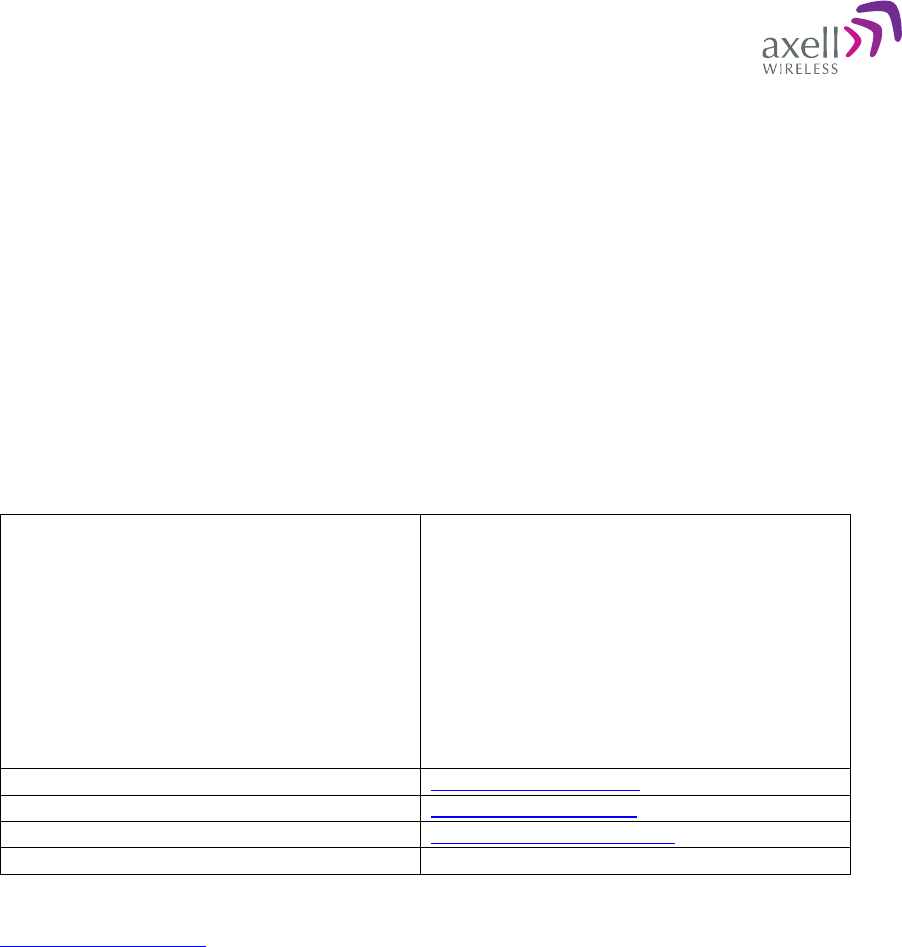
R
EPEATER
A
XELL
D-MBR-USA
PRODUCT DESCRIPTION AND USER’S MANUAL
II Axell Wireless Ltd
Copyright © 2011 Axell Wireless Ltd
All rights reserved.
No part of this document may be copied, distributed, transmitted, transcribed, stored in a retrieval system, or
translated into any human or computer language without the prior written permission of Axell Wireless Ltd.
The manufacturer has made every effort to ensure that the instructions contained in this document are
adequate and free of errors and omissions. The manufacturer will, if necessary, explain issues which may not
be covered by this document. The manufacturer's liability for any errors in the document is limited to the
correction of errors and the aforementioned advisory services.
This document has been prepared to be used by professional and properly trained personnel, and the
customer assumes full responsibility when using them. The manufacturer welcomes customer comments as
part of the process of continual development and improvement of the documentation in the best way possible
from the user's viewpoint. Please submit your comments to the nearest Axell Wireless sales representative.
Contact Information
Headquarters Axell Wireless
Aerial House
Asheridge Road
Chesham
Buckinghamshire HP5 2QD
United Kingdom
Tel: +44 1494 777000
Fax: +44 1494 777002
Commercial inquiries
info@axellwireless.com
Web site
www.axellwireless.com
Support issues
support@axellwireless.com
Technical Support Line, English speaking +44 1494 777 777
Contact information for Axell Wireless offices in other countries can be found on our web site,
www.axellwireless.com

R
EPEATER
A
XELL
D-MBR-USA
PRODUCT DESCRIPTION AND USER’S MANUAL
© Axell Wireless Ltd III
About This Manual
This Product Manual provides the following information:
• Description of the Repeater
• Procedures for setup, configuration and checking the proper operation of the Repeater
• Maintenance and troubleshooting procedures
For whom it is Intended
This Product Manual is intended for experienced technicians and engineers. It is assumed that the
customers installing, operating, and maintaining Axell Wireless Repeaters are familiar with the basic
functionality of Repeaters.
Notice
Confidential - Authorized Customer Use
This document may be used in its complete form only and is solely for the use of Axell Wireless
employees and authorized Axell Wireless channels or customers. The material herein is proprietary to
Axell Wireless. Any unauthorized reproduction, use or disclosure of any part thereof is strictly
prohibited.
All trademarks and registered trademarks are the property of their respective owners.
Disclaimer of Liability
Contents herein are current as of the date of publication. Axell Wireless reserves the right to change
the contents without prior notice. The information furnished by Axell Wireless in this document is
believed to be accurate and reliable. However, Axell Wireless assumes no responsibility for its use.
In no event shall Axell Wireless be liable for any damage resulting from loss of data, loss of use, or
loss of profits and Axell Wireless further disclaims any and all liability for indirect, incidental,
special, consequential or other similes damages. This disclaimer of liability applies to all products,
publications and services during and after the warranty period.
Safety Warnings and Admonishments
Throughout this manual, important safety warnings and admonishments are included to warn of
possible hazards to persons or equipment. A safety warning identifies a possible hazard and then
describes what may happen if the hazard is not avoided. The safety warnings
–
in the form of
Dangers, Warnings and Cautions must be followed at all times. These warnings are flagged by the
use of a warning icon, usually the triangular alert icon seen below. The exclamation point within the
triangular alert icon is intended to warn the operator or service personnel of operation and
maintenance from factors relating to the product and its operating environment, which could pose a
safety hazard.
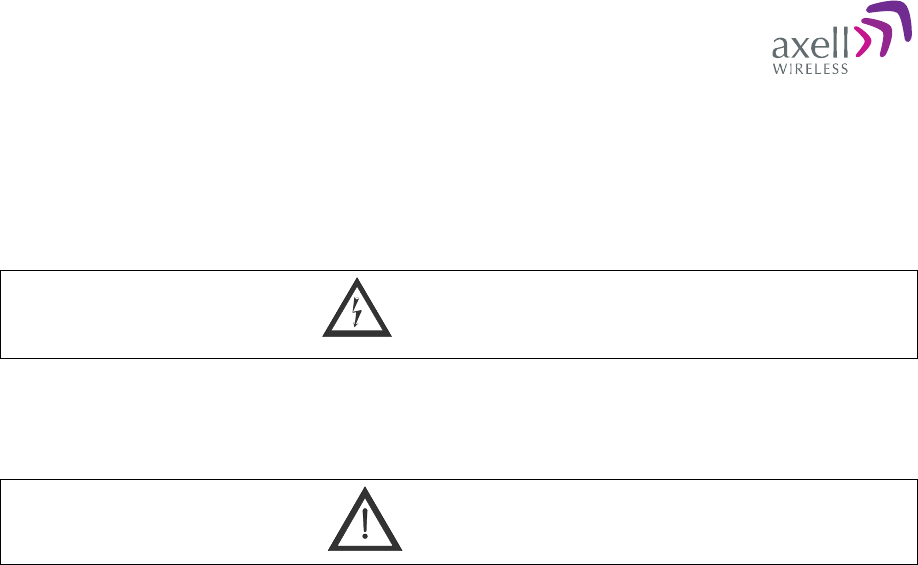
R
EPEATER
A
XELL
D-MBR-USA
PRODUCT DESCRIPTION AND USER’S MANUAL
IV Axell Wireless Ltd
General Safety Warnings Concerning Use of This System
Always observe standard safety precautions during installation, operation and maintenance of this
product. Only a qualified and authorized personnel should carry out adjustment, maintenance or
repairs to the components of this equipment.
Danger: Electrical Shock
To prevent electrical shock when installing or modifying the system power wiring, disconnect the
wiring at the power source before working with un insulated wires or terminals.
Caution: RF Exposure
Installation of an antenna must comply with the FCC RF exposure requirements.
Exclusive Remedies
The remedies provided herein are the Buyer’s sole and exclusive remedies. Axell Wireless shall not
be viable for any direct, incidental, or consequential damages, whether based on contract, tort, or any
legal theory.

A
XELL
D-MBR-USA-USA
R
EPEATER
PRODUCT DESCRIPTION AND USER’S MANUAL
Axell Wireless Ltd V
Table of Contents
1 Introduction ................................................................................................................ 1
1.1
Features ................................................................................................................................ 2
1.2
Models and Ordering Information ...................................................................................... 3
1.3
Smart-ALC Function ............................................................................................................ 4
1.4
Axell D-MBR-USA Interfaces ............................................................................................... 5
1.5
Modem Support .................................................................................................................... 6
2 Antenna Specifications and Installation Requirements........................................... 7
2.1
Base (Donor) Antenna ......................................................................................................... 7
2.1.1
Required Antenna Information .................................................................................. 7
2.1.2
Donor Antenna specifications .................................................................................... 7
2.1.3
Installation Criteria ..................................................................................................... 7
2.2
Mobile (Service) Antenna .................................................................................................... 8
2.2.1
Required Antenna Information .................................................................................. 8
2.2.2
Recommended Antennas .......................................................................................... 8
2.2.3
Mobile (Service) Antenna Installation Criteria ........................................................... 8
3 Installing the Repeater ............................................................................................... 9
3.1
Repeater Pre-Installation Requirements ............................................................................ 9
3.1.1
Safety Guidelines ...................................................................................................... 9
3.1.2
Required BTS Information ......................................................................................... 9
3.1.3
RF Cable Installation Guidelines ............................................................................... 9
3.2
Overview of the Installation Procedure ........................................................................... 10
3.3
Required Tools and Materials ........................................................................................... 10
3.4
Unpacking ........................................................................................................................... 10
3.5
Criteria for Repeater Installation Location ...................................................................... 11
3.6
For GSM/GPRS Modems – SIM Card Installation ............................................................ 12
3.7
Before Connecting the Antennas or Power ..................................................................... 13
3.7.1
Verifying Isolation between Donor and Mobile Antennas ....................................... 13
3.7.2
Verify Link between BTS and Repeater .................................................................. 14
3.8
Antenna Connections ........................................................................................................ 15
3.9
Grounding ........................................................................................................................... 16
3.10
Power Connections ............................................................................................................ 17
3.11
Dry Contact Alarm Connections ....................................................................................... 18
4 Initial Setup and Commissioning .............................................................................19
4.1
Open a Local WEB Session to the Repeater ................................................................... 19
4.1.1
Connect the Repeater to the Computer .................................................................. 19
4.1.2
Configure the Computer Network Parameters ........................................................ 19
4.1.3
Login to the Repeater .............................................................................................. 22
4.2
Navigating the Web GUI Application ................................................................................ 23
4.2.1
Operation Buttons ................................................................................................... 24
4.2.2
Service Pane and Tabs ........................................................................................... 24
4.2.3
CMU Pane and Tabs ............................................................................................... 24
4.3
Signal Levels and Channel Configuration ....................................................................... 25
4.3.1
RF Gain Setting Criteria .......................................................................................... 25
4.3.2
Adjusting the Signal Levels and Configuring Channels .......................................... 25
4.4
Setting Date and Time ....................................................................................................... 28

A
XELL
D-MBR-USA
R
EPEATER
PRODUCT DESCRIPTION AND USER’S MANUAL
VI Axell Wireless Ltd
4.5
Configuring External Alarms ............................................................................................ 29
4.6
Communication and System Parameters ........................................................................ 30
4.6.1
The Communication Configuration Tab .................................................................. 30
4.6.2
IP Address Configuration ........................................................................................ 30
4.7
Modem Communication Setup ......................................................................................... 31
4.7.1
GSM/GPRS Communication ................................................................................... 32
4.7.2
Verizon CDMA Modem Communication Configuration ........................................... 33
4.7.3
Direct Circuit Switch Connection ............................................................................. 35
4.8
Configuring Notification Method - SNMP Trap or SMS .................................................. 36
4.8.1
Configuring SNMP Trap Destinations ..................................................................... 36
4.8.2
Configuring SMS Notification Destinations ............................................................. 37
4.8.3
AEM (Axell Element Manager) Configuration ......................................................... 37
5 Administrative Operations ....................................................................................... 38
5.1
User Management .............................................................................................................. 38
5.1.1
User Levels .............................................................................................................. 38
5.1.2
Viewing the List of Defined Users ........................................................................... 38
5.1.3
Adding Users ........................................................................................................... 39
5.1.4
Editing a User .......................................................................................................... 39
5.1.5
Deleting a User ........................................................................................................ 40
5.2
Viewing Band Information ................................................................................................. 40
5.3
CMU Software Upgrade ..................................................................................................... 41
6 Monitoring and Troubleshooting ............................................................................. 42
6.1
Shutdown and Recovery Mechanism............................................................................... 42
6.2
Alarms Screen .................................................................................................................... 43
6.3
Alarms Log .......................................................................................................................... 45
6.4
D-MBR-USA Front Panel LED Troubleshooting .............................................................. 46
Appendix A: Specifications ............................................................................................. 47
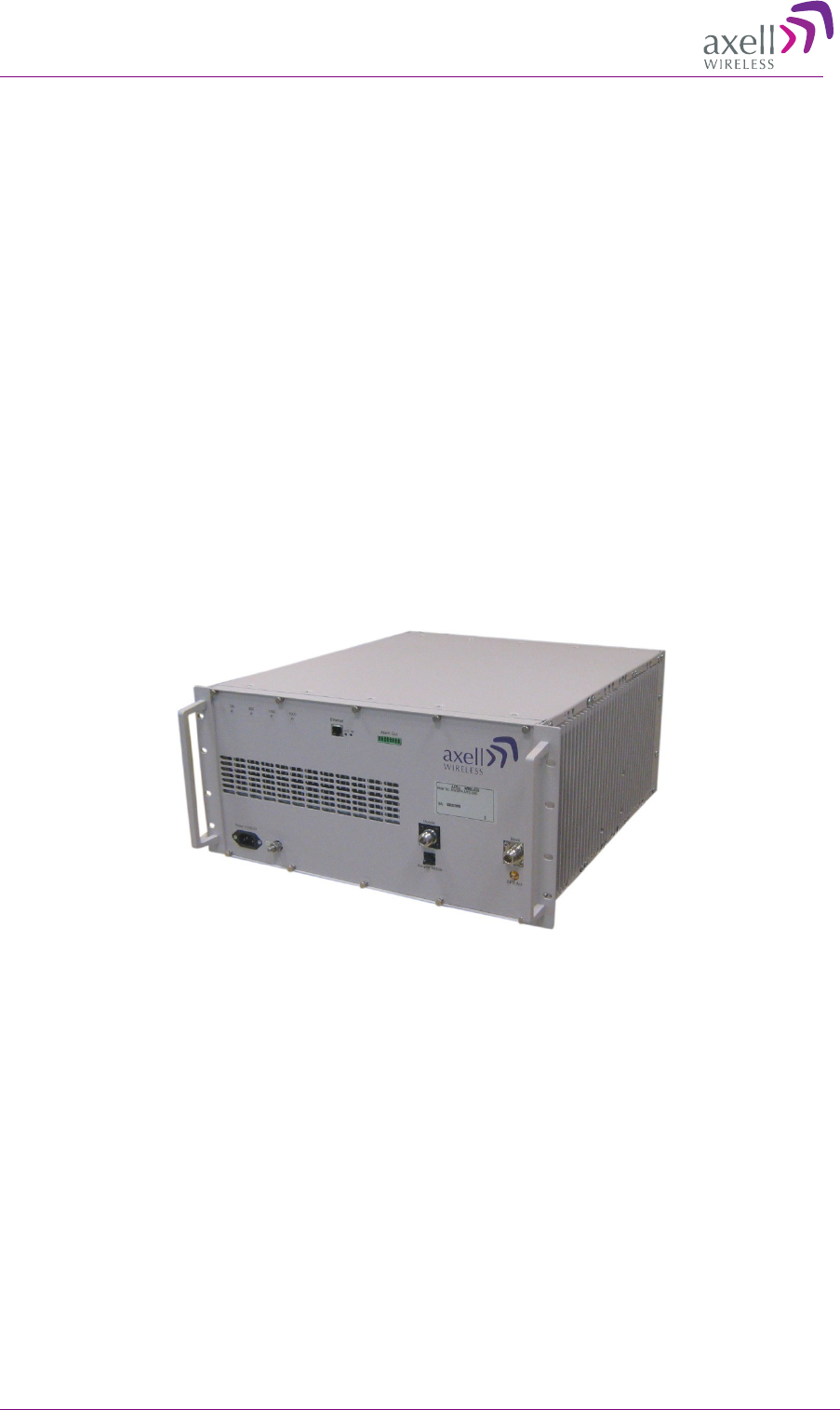
A
XELL
D-MBR-USA-USA
R
EPEATER
PRODUCT DESCRIPTION AND USER’S MANUAL
Axell Wireless Ltd 1
1 Introduction
Axell’s Digital Multi-Band Repeater for USA (D-MBR-USA) is an in-building, band-selective
repeater with advanced digital filtering capabilities that operates in the LTE 700MHz (simultaneously
in upper and lower band), CELL 850MHz, AWS 1700MHz and PCS 1900MHz bands. It provides an
excellent single unit solution for multi-operators or for operators with a non-contiguous spectrum.
Up to eight or twelve (model dependent) non-contiguous sub-bands can be user configured for each
band, where the gain and power of each of the sub-bands can be individually defined.
The Repeater provides highly accurate out-of-band-rejection and simple, GUI based procedures for
adjusting the pass band according to the relevant frequency spectrums.
D-MBR-USA includes the SmartALC power control algorithm that automatically optimizes the gain
setting by learning the actual range of RSSI levels over a user-specified period of time. The
SmartALC algorithm prevents oscillations, reduces the amount of isolation required by the system
and optimizes the system to minimize noise rise at the donor cell site.
GUI based web management is supported through both Ethernet and remote wireless connections
provided by an integrated CDMA modem. Local setup can be performed through a connection to the
Ethernet port using a cross-cable.
Figure 1. Axell D-MBR-USA Repeater

A
XELL
D-MBR-USA
R
EPEATER
PRODUCT DESCRIPTION AND USER’S MANUAL
2 Axell Wireless Ltd
1.1 Features
• Indoor Repeater supporting the following bands:
• LTE 700 MHz – simultaneously over the complete upper and lower band spectrum
• CELL 850 MHz, AWS 1700MHz and PCS 1900 MHz.
• Composite Downlink Output Power:
• LTE 700 MHz: 33 dBm
• CELL 850MHz: 33 dBm
• AWS 1700MHz: 30 dBm
• PCS 1900 MHz: 30 dBm
• Composite Uplink Output Power: + 27 dBm per band
• RF Gain: 80 dB
• Single module support for Lower/Upper LTE 700MHz band
• Up to 8 or 12 software selectable non-contiguous sub-bands with individual gain and power
settings for each sub-band – the number of supported sub-bands depends on the defined
bandwidth of each sub-band
• High linear amplification and spectral purity
• Excellent out-of-band interference prevention
• Highly accurate frequency selection
• SmartALC™ technology:
• Automatically sets optimum gain
• Prevents oscillations and balances coverage
• Ensures transparent network operation
• Simple mounting in a standard 19” rack
• Simple setup via an intuitive GUI application
• Simultaneous support for both static and dynamic address allocation (two independent IPs)
• Supports SMS and SNMP fault notification
• Remote Web access monitoring and control via either an Ethernet or a wireless connection
(implemented through an integrated GPRS/CDMA modem)

A
XELL
D-MBR-USA
R
EPEATER
PRODUCT DESCRIPTION AND USER’S MANUAL
© Axell Wireless Ltd 3
1.2 Models and Ordering Information
Part Number Product Name Service & Frequency
[MHz]
Supported sub-bands
/filter
D-MBR-CH DMBR Chassis
4 band D-MBR chassis,
power supply,
communication card
--
D-MBR-CDMA-M DMBR Modem D-MBR CDMA 1X
Modem --
D-BM-3307 DMBR 700 33 dBm
module
33 dBm, 8 filter 700 LTE
module for DMBR
700 - all LTE filters
1.4/3/5/10/15/20 MHz
D-BM-3307-12 DMBR 700 33 dBm module 33 dBm, 12 filter 700
LTE module for DMBR
700 - all LTE filters
1.4/3/5/10/15/20 MHz
D-BM-3308 DMBR 850 33 dBm module
33dBm, 8 filter 850
Cellular module for
DMBR
Cellular A , A' , A'', B, B'
, up to 25MHz in
2.5MHz steps and all
LTE filters;
D-BM-3308-12 DMBR 850 27 dBm module
33 dBm, 12 filter 850
Cellular module for
DMBR
Cellular A , A' , A'', B, B'
, up to 25MHz in
2.5MHz steps and all
LTE filters;
D-BM-3017 DMBR 1700 30 dBm
module
30 dBm, 8 filter 1700
AWS module for DMBR
AWS up to 20Mhz in
2.5Mhz steps and all LTE
filters
D-BM-3017-12 DMBR 1700 30 dBm
module
30 dBm, 12 filter 1700
AWS module for DMBR
AWS up to 20Mhz in
2.5Mhz steps and all LTE
filters
D-BM-3019 DMBR 1900 30 dBm
module
30 dBm, 8 filter 1900
PCS module for DMBR
PCS up to 20Mhz in
2.5Mhz steps and all LTE
filters
D-BM-3019-12 DMBR 1900 30 dBm
module
30 dBm, 12 filter 1900
PCS module for DMBR
PCS up to 20Mhz in
2.5Mhz steps and all LTE
filters
D-MBR-9P D-MBR 9 Plexer
9 Plexer to support 700 /
850 / AWS / PCS for
DMBR
700 / 850 / 1700 / 1900
D-MBR-7P-7-8-19 D-MBR 7 Plexer 7 Plexer to support 700 /
850 / PCS for DMBR 700 / 850 / 1900
D-MBR-7P-7-8-17 D-MBR 7 Plexer 7 Plexer to support 700 /
850 / AWS for DMBR 700 / 850 / 1700
D-MBR-7P-7-17-19 D-MBR 7 Plexer 7 Plexer to support 700 /
PCS /AWS for DMBR 700/1700/1900

A
XELL
D-MBR-USA
R
EPEATER
PRODUCT DESCRIPTION AND USER’S MANUAL
4 Axell Wireless Ltd
Part Number Product Name Service & Frequency
[MHz]
Supported sub-bands
/filter
D-MBR-6P D-MBR 6 Plexer 6 Plexer to support 850 /
AWS / PCS for DMBR 850 / 1700 / 1900
D-MBR-5P-7-19 D-MBR 5 Plexer 5 Plexer to support 700 /
PCS for DMBR 700 / 1900
D-MBR-5P-7-8 D-MBR 5 Plexer 5 Plexer to support 700 /
850 for DMBR 700 / 850
D-MBR-4P-8-19 D-MBR 4 Plexer 4 Plexer to support 850 /
PCS for DMBR 850 / PCS
D-MBR-3P-7 D-MBR 3 Plexer 3 Plexer to support 700
only for DMBR 700
D-MBR-2P -8 D-MBR 2 Plexer 2 Plexer to support 850
for D-MBR 850
D-MBR-2P -17 D-MBR 2 Plexer 2 Plexer to support AWS
for D-MBR 1700
D-MBR-2P -19 D-MBR 2 Plexer 2 Plexer to support PCS
for D-MBR 1900
D-MBR-WM-AK D-MBR AK Wall mount accessory kit
for DMBR
1.3 Smart-ALC Function
The Smart Automatic Level Control (Smart-ALC) is an innovative algorithm for automatic repeater
gain adjustment. Combined with advanced control algorithms, SALC is capable of learning the traffic
load characteristics and adjusting the Repeater RF Gain to the desired value.
Smart ALC eliminates the need to perform initial settings for maximal traffic load conditions and on-
site gain adjustments.
Smart-ALC maintains the Uplink/Downlink gain balance for system transparency. In addition, Smart-
ALC prevents oscillations that may occur due to insufficient isolation while maintaining the gain in a
linear range operation by adjusting the repeater paths’ gain accordingly.
IMOP (Isolation Measurement and Oscillation Prevention) algorithm effectively reduces oscillation
problems.
The repeater’s power amplifier includes power-monitoring circuits with Automatic Level Control
(ALC) that prevents excessive output power while maintaining the power amplifier linearity.
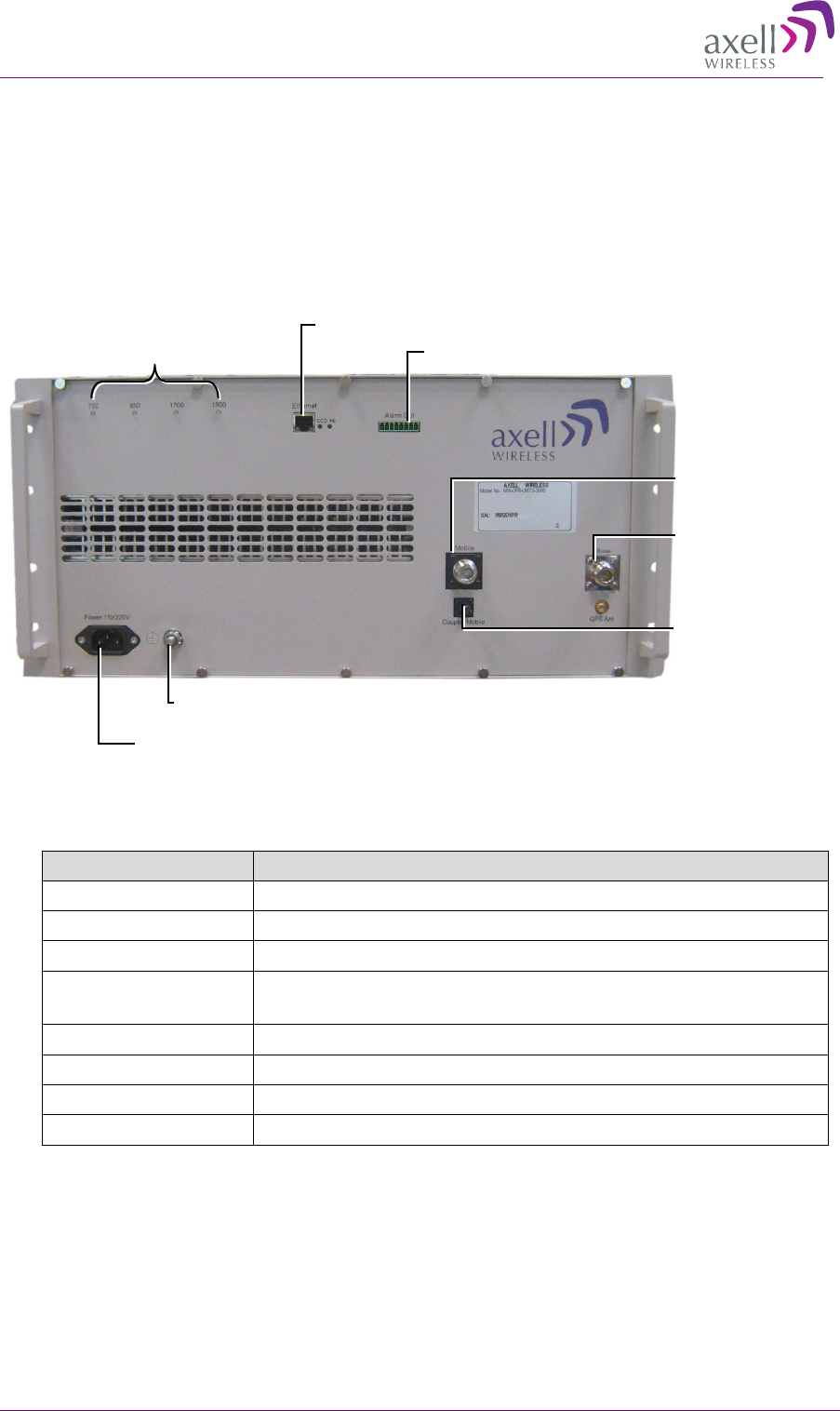
A
XELL
D-MBR-USA
R
EPEATER
PRODUCT DESCRIPTION AND USER’S MANUAL
© Axell Wireless Ltd 5
1.4 Axell D-MBR-USA Interfaces
The repeater’s interfaces are located on the front panel. These include Ethernet port, Mobile and
Base antenna connections, Alarm I/O, LED indicators, and power connection
Figure 2. D-MBR-USA Front Panel
The following table provides a description of the front panel ports and connections.
Interface Description
ETHERNET
RJ45 Ethernet port for Web management.
MOBILE
Service antenna RF connection. See section 3.8
BASE
Donor antenna RF connection. See section 3.8
COUPLERS MOBILE
SMA Female Mobile coupling connectors (-20 dB). Used to test
input signals from the Base and Mobile antennas.
ALARM OUT
Dry-contact alarm port for external alert devices. See section 3.11.
GPS
N/A
POWER
Connection to 110/220VAC.
GND
Ground connection
Unit AC power
connection
Mobile/Service
antenna connection
LED indicators
corresponding to each service
Ethernet connection
Dry contact alarms port
Base/Donor
antenna connection
Coupler Mobile
GND

A
XELL
D-MBR-USA
R
EPEATER
PRODUCT DESCRIPTION AND USER’S MANUAL
6 Axell Wireless Ltd
The front panel also includes the following LED indicators:
Indicator Description
700
(LTE)
850
(CELL)
1700
(AWS)
1900
(PCS)
One Indicator per –band:
RED Steady - service muted due to
general fault
Blinking – service muted by user
ORANGE Blinking – service initiating
on power up or reset
Steady – high DL/UL signal or VSWR
GREEN and
ORANGE
Blinking- Reduced gain by IMOP
GREEN Blinking – DL power below threshold
Steady - normal service operation
MDM
(
NEAR
RJ45
CONNECTOR
)
• Green Steady - modem is either not defined, or defined modem
is operating normally.
• Orange Steady– modem is trying to connect
• Red Steady– modem failed to connect
CCD
(
NEAR
RJ45
CONNECTOR
)
Green Blinking – normal operation of CCD
1.5 Modem Support
The Repeater supports two types of integrated modems that required different setup procedures:
• CDMA – modem is continuously ON. Setup according to section 4.7.2
• GSM/GPRS – insert SIM card according to section 3.6 and setup up modem according to section
4.7.

A
XELL
D-MBR-USA
R
EPEATER
PRODUCT DESCRIPTION AND USER’S MANUAL
© Axell Wireless Ltd 7
2 Antenna Specifications and Installation
Requirements
This chapter provides information on the specifications of the donor and service antennas suitable for
operation with this repeater, and on the installation requirements of the antennas.
2.1 Base (Donor) Antenna
The Base (Donor) antenna is usually installed outdoors and is either a directional antenna such as a
Yagi or a Panel antenna.
2.1.1 Required Antenna Information
You will require the following antenna information
• Antenna type and characteristics
• Height
• Length and type of coaxial cable required for connecting the Donor antenna to the Repeater and
the attenuation.
2.1.2 Donor Antenna specifications
• Yagi type or similar – 12 to 20 dBi gain, very sharp beam pointed to the BTS.
• Cable and jumper loss is at least 2dB.
• Example of antenna's typical specifications:
Gain: 8 dBd (=10.1 dBi)
VSWR: < 1:5:1
Impedance: 50 ohm
2.1.3 Installation Criteria
NOTE: Verify that the antennas meet requirements described in section
2.1.
Installation requirements:
• Select a location for the Donor antenna and verify that there is enough signal strength at that
location.
• Install the Donor Antenna at the designated height.
• The antenna should point to the direction of the base station for maximum input power.
• Verify that the antenna is in the base stations line of sight (raise the antenna if necessary).
• Install the donor antenna at a higher level (i.e. floor) than the mobile antenna.
• Must be installed at a minimum distance of 1 meter from any personnel within the area.

A
XELL
D-MBR-USA
R
EPEATER
PRODUCT DESCRIPTION AND USER’S MANUAL
8 Axell Wireless Ltd
2.2 Mobile (Service) Antenna
The Mobile (Service) antenna is installed indoors and the type depends on the application.
2.2.1 Required Antenna Information
The following antenna requirements, specifications and site considerations should be met.
• Service area type and size
• Antenna type and characteristics
• Height
• Length and type of coaxial cable required for connecting the Donor antenna to the Repeater and
the attenuation.
2.2.2 Recommended Antennas
The following describes the requirements for an omni-directional mobile used for indoor
applications.
Specifications:
• One or a combination of the following antennas can be used: Ceiling Mount Patch antenna, Wall
Mount Patch antenna, Corner Reflector.
• Omni directional antenna with a 0 to 2 dBi typical gain, or wide beam with up to 10 dBi gain.
• Example of omni-directional antenna specifications:
Gain: 0 to 2 dBi
VSWR: < 2:1
Impedance: 50 ohm
• Choose an antenna with high side lobe attenuation which enables maximum isolation from the
service/ mobile antenna.
2.2.3 Mobile (Service) Antenna Installation Criteria
Determine the antenna installation configuration, according to the transmission requirements and the
installation site conditions.
Installation requirements:
• An indoor antenna should be installed at a convenient location. It should be free of metallic
obstruction.
• Install the Service Antenna at the designated height and tune it roughly toward the Service
coverage area.
• Installation of this antenna must provide a minimum separation distance of 20 cm from any
personnel within the area.
Note: If the power is divided into more than 5 antennas that have a large coverage area than the
separation distance can be less than 20 cm.
• Cable and jumper loss is at least 2dB.

A
XELL
D-MBR-USA
R
EPEATER
PRODUCT DESCRIPTION AND USER’S MANUAL
© Axell Wireless Ltd 9
3 Installing the Repeater
3.1 Repeater Pre-Installation Requirements
3.1.1 Safety Guidelines
Before installing the Repeater, review the following safety information:
• Follow all local safety regulations when installing the Repeater.
• Only qualified personnel are authorized to install and maintain the Repeater.
• Ground the Repeater with the grounding bolt located on the external lower side of the Repeater).
• Do not use the grounding bolt to connect external devices.
• Follow Electro-Static Discharge (ESD) precautions.
• Use low loss cables to connect the antennas to the Repeater.
3.1.2 Required BTS Information
Required BTS Information
• BTS channels
• BTS output power per channel
• BTS antenna gain
• BTS antenna height
• Distance from Repeater site to BTS
3.1.3 RF Cable Installation Guidelines
Required:
•
For all coaxial connections to/from the Repeater - high performance, flexible, low loss 50Ω
coaxial communications cable.
• All cables shall be weather-resistant type
.
• Cable length - determined by the Repeater installation plan. When calculating the cable length,
take into account excess cable slack so as not to limit the insertion paths.

A
XELL
D-MBR-USA
R
EPEATER
PRODUCT DESCRIPTION AND USER’S MANUAL
10 Axell Wireless Ltd
3.2 Overview of the Installation Procedure
NOTE: The Donor and Mobile antennas can be positioned and installed (without connection to the
Repeater) at any time either before or after mounting the Repeater.
1. Unpack the Repeater kit.
2. Install the Repeater in the rack
3. For GPRS modems only: Open the Repeater and insert the SIM card. (CDMA modems do NOT
required SIM cards).
4. Before powering up the Repeater:
• Verify isolation between the donor and mobile antennas
• Verify link between the BTS and Base Repeater.
5. Connect the antennas to the Repeater
6. GND and Power-up the Repeater.
7. Optional - Connect the dry-contact alarms. This can be done at any time, before or after
powering up the Repeater.
3.3 Required Tools and Materials
• Standard professional tool box (not supplied)
3.4 Unpacking
Upon receiving the D-MBR-USA, perform the following:
1. Examine the shipping container for damage before unpacking the unit.
2. Perform a visual inspection to reveal any physical damage to the equipment.
3. Verify that all of the equipment (listed below) is included. Otherwise contact Axell Wireless Ltd.
• D-MBR-USA Repeater
• AC power cable
• Alarms cable
• Ethernet cross cable – for setup connection between computer and Repeater
• RS232 cable for CDMA modem setup
• CD with documentation

A
XELL
D-MBR-USA
R
EPEATER
PRODUCT DESCRIPTION AND USER’S MANUAL
© Axell Wireless Ltd 11
3.5 Criteria for Repeater Installation Location
NOTE: The D-MBR-USA Repeater is usually installed in a rack-type enclosure in the communication
room.
The following criteria should be considered when selecting the Repeater installation site location:
• Install the Repeater in a shielded, ventilated, and easy-to-reach area.
• Ventilation:
• The repeater is cooled by forced air provided internally by high MTBF fan. Allow air
flow at front and rear of the Repeater.
• Ensure that adequate airflow and ventilation within the rack and around the installed
components so that the safety of the equipment is not compromised. It is
recommended to allow for at least about 2 cm of airspace between devices in the rack.
• Follow Electro-Static Discharge (ESD) precautions.
• Install the Repeater close to the service area to monitor the output power and noise figure.
• Use low loss cables to connect the antennas to the Repeater.
• Only trained and qualified personnel should be allowed to install or replace this equipment.
• Verify that ambient temperature of the environment does not exceed 55°C (131°F)
• Verify that the equipment is grounded as required – especially the supply connections.
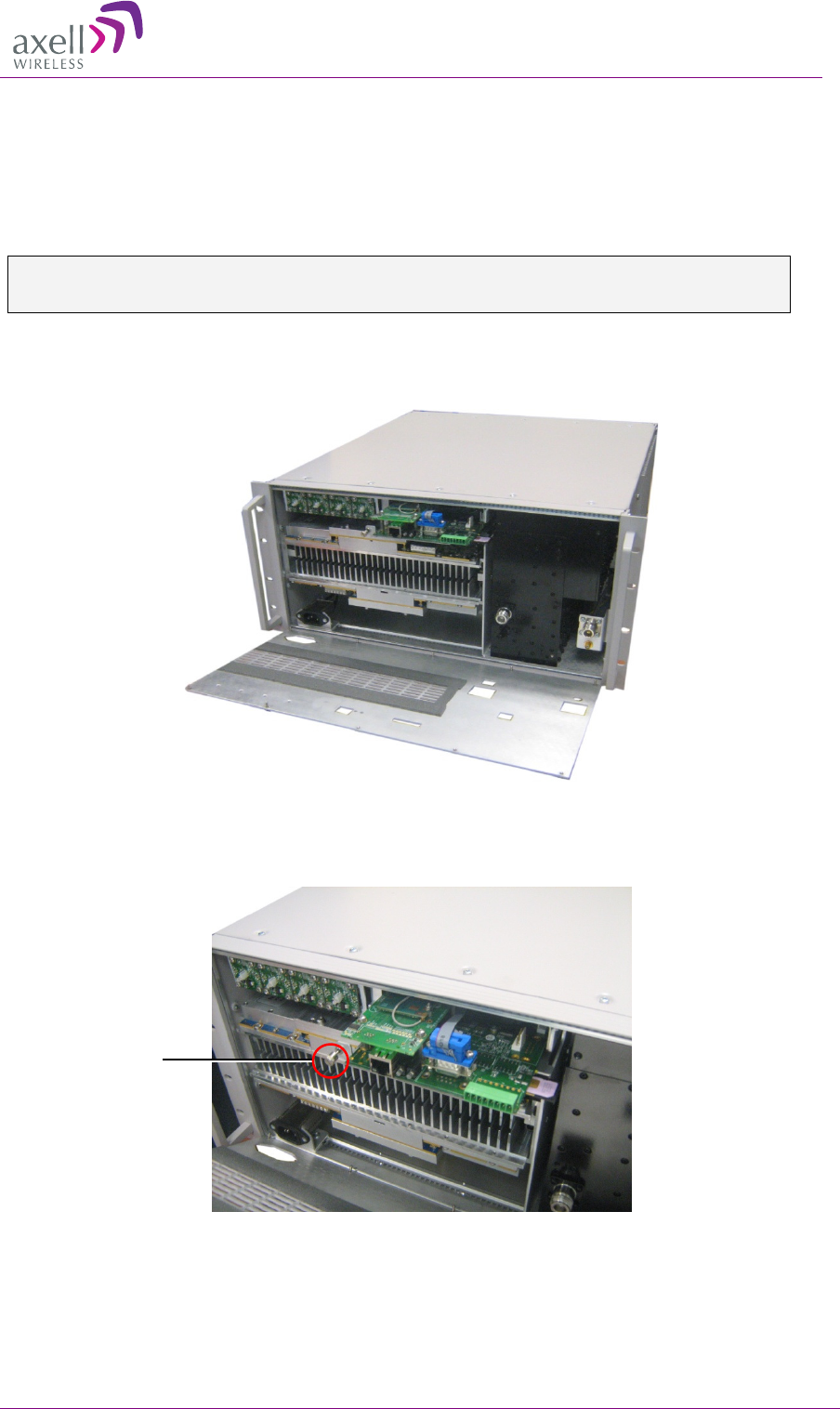
A
XELL
D-MBR-USA
R
EPEATER
PRODUCT DESCRIPTION AND USER’S MANUAL
12 Axell Wireless Ltd
3.6 For GSM/GPRS Modems – SIM Card
Installation
This procedure is NOT relevant for CDMA modems. CDMA modems do NOT require SIM cards.
WARNING! Be sure that the repeater is powered off (disconnect the power
connector) before inserting or removing the SIM card.
To install the SIM card
1. Remove the Repeater front panel by releasing the captive screws.
Figure
3-1. Opening Front Panel
2. Release the captive-screw on the modem card and gently pull modem card half-way out.
Figure
3-2. D-MBR Captive Screw
Modem card
captive screw
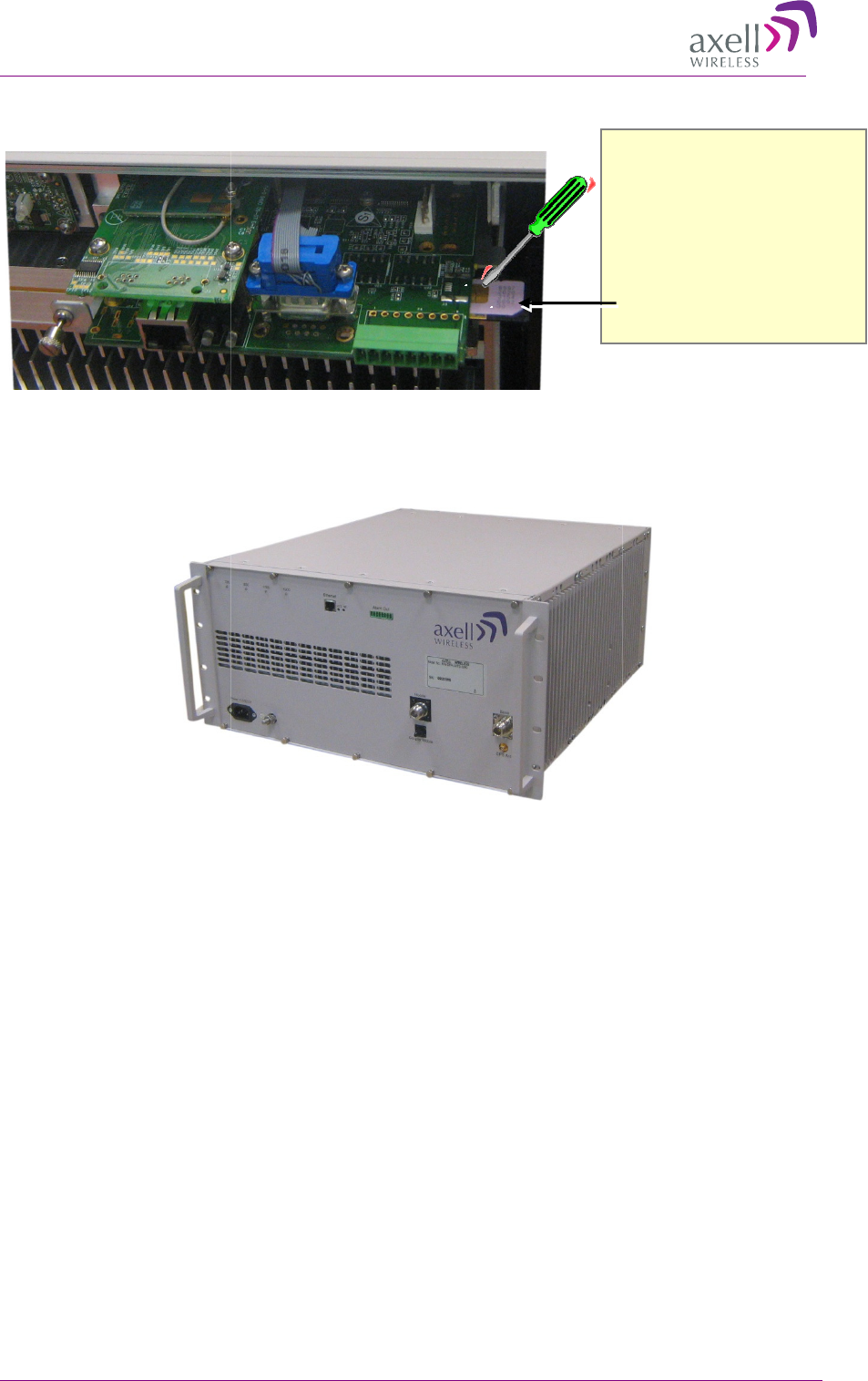
A
XELL
D-MBR-USA
R
EPEATER
PRODUC
T DESCRIPTION AND US
© Axell Wireless Ltd
3. P
ress the protrusion on the right side to extract the SIM card tray.
Figure
4. P
lace the SIM card in the tray and push the tray in gently
5.
Push the card in again, close the cover and tighten the captive screws.
3.7
Before Connecting the Antennas or Power
Before connecting the antennas or power pe
•
Verify isolation between the donor and mobile antennas
•
Verify link between BTS and Repeater
3.7.1
Verifying Isolation between Donor and Mobile Antennas
The isolation between the Base/Donor and Mobile/Ser
gain, outdoor applications.
For proper operation of the Repeater, it is recommended that the isolation between the Donor and
Service antennas be at least 12dB higher than the Repeaters set gain.
EPEATER
T DESCRIPTION AND US
ER’S MANUAL
ress the protrusion on the right side to extract the SIM card tray.
Figure
3-3. Extracted SIM Card Tray
lace the SIM card in the tray and push the tray in gently
until it clicks.
Push the card in again, close the cover and tighten the captive screws.
Figure
3-4. D-MBR with Secured Cover
Before Connecting the Antennas or Power
Before connecting the antennas or power pe
rform the following procedures described in this section:
Verify isolation between the donor and mobile antennas
Verify link between BTS and Repeater
Verifying Isolation between Donor and Mobile Antennas
The isolation between the Base/Donor and Mobile/Ser
vice antennas is critical especially for high
For proper operation of the Repeater, it is recommended that the isolation between the Donor and
Service antennas be at least 12dB higher than the Repeaters set gain.
1
2
3
13
Before Connecting the Antennas or Power
rform the following procedures described in this section:
Verifying Isolation between Donor and Mobile Antennas
vice antennas is critical especially for high
For proper operation of the Repeater, it is recommended that the isolation between the Donor and
1
. Press right-side protrusion
CONTINUOUSLY until
the SIM tray comes OUT.
2
. You may need to use as
small sharp object (
do NOT
use a pencil).
3
.
Insert SIM card and push in
gently till it CLICKS.

A
XELL
D-MBR-USA
R
EPEATER
PRODUCT DESCRIPTION AND USER’S MANUAL
14 Axell Wireless Ltd
To measure the isolation, proceed as follows:
1. Inject a known signal from a signal generator into one antenna (preferably the Donor antenna).
2. Measure the coupled output from the Service antenna, using the Spectrum analyzer and LNA if
applicable.
3. Perform this procedure across the frequency range of both the Uplink and Downlink bands.
4. Register the lower result for system operation.
3.7.2 Verify Link between BTS and Repeater
WARNING! Perform this procedure before connecting the antennas to the Repeater
or powering on the Repeater. The Repeater should not be operated prior to the
verification of the operating parameter in its installation environment.
Before connecting the antennas or powering up the Repeater, verifying the Link
between the BTS and the Repeater
This test checks the signal strength from the BTS antenna to the Repeater.
Proceed as follows:
1. Using a Spectrum analyzer, measure the received signal from BTS at the Donor antenna port near
the Repeater.
2. Adjust the Donor antenna direction to receive the maximum signal strength.
3. Compare the received signal strength with the calculated signal strength from the design phase.
In case of discrepancy, check for one of the following:
• Antenna out of direction
• Antenna tuned to side lobe instead of main lobe
• Antenna connector or antenna cable faulty
• Line-of-sight problem (obstruction), etc.
4. Register the signal strength of the downlink channel for the system operation phase.

A
XELL
D-MBR-USA
R
EPEATER
PRODUCT DESCRIPTION AND USER’S MANUAL
© Axell Wireless Ltd 15
3.8 Antenna Connections
CAUTION! Do not connect the antenna cables to the Repeater before verifying the
installation parameters.
DO NOT POWER-UP the Repeater without either the antennas being connected or
the antenna connections terminated with dummy loads.
To connect the antennas to the Repeater
NOTE: If the coaxial cables are NOT weather-resistant type, wrap the exterior coaxial cables with
insulation and holding tape (Type 3M Rubber splicing tape) for environmental protection and to
ensure longer lifetime.
1. Install the antenna cables along their path to the Repeater, and connect them to the Antennas.
Note: Be sure to use low loss cables.
2. Connect the Donor antenna to the Repeater BASE port. (Donor antenna specifications and
installation criteria are described in section
2.1).
3. Verify all RF connectors are tightened and the cables and antennas are secured.
4. Connect the Service antenna to the Repeater MOBILE port. (Mobile antenna specifications and
installation criteria are described in section
2.2).
5. Verify all RF connectors are tightened and the cables and antennas are secured.
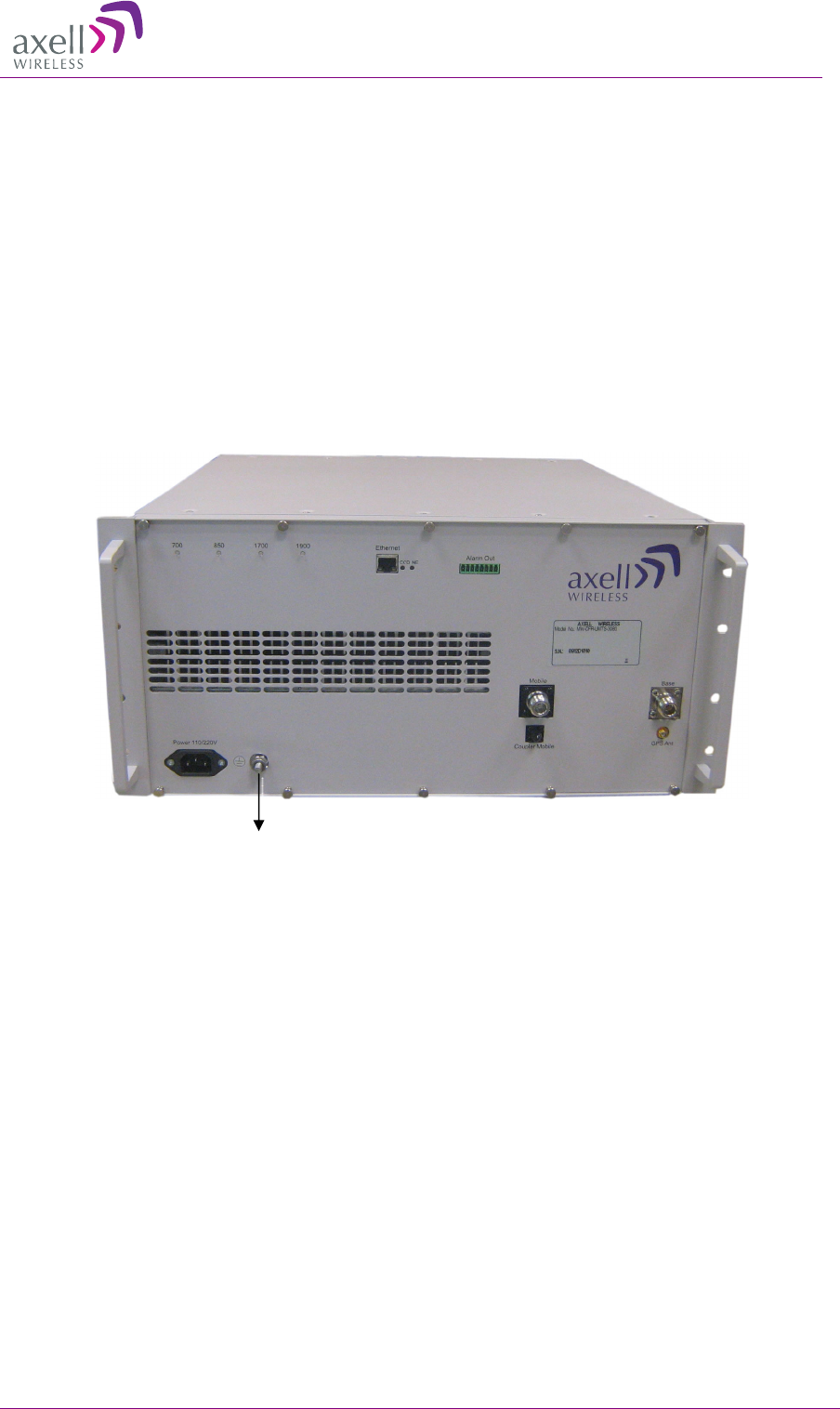
A
XELL
D-MBR-USA
R
EPEATER
PRODUCT DESCRIPTION AND USER’S MANUAL
16 Axell Wireless Ltd
3.9 Grounding
Requirements for grounding wires
• Protective grounding conductor - should be aluminum with cross-section 10AWG.
• Lug of the protective grounding conductor - should be aluminum
• Washers and screw - should be high Cr stainless steel, or 12% Cr stainless steel, or Cr on, Ni on
steel, tin on steel
• The protective grounding conductor is copper with a 10AWG cross-section.
To ground repeater
Connect main ground to Repeater grounding lug.
GND connector
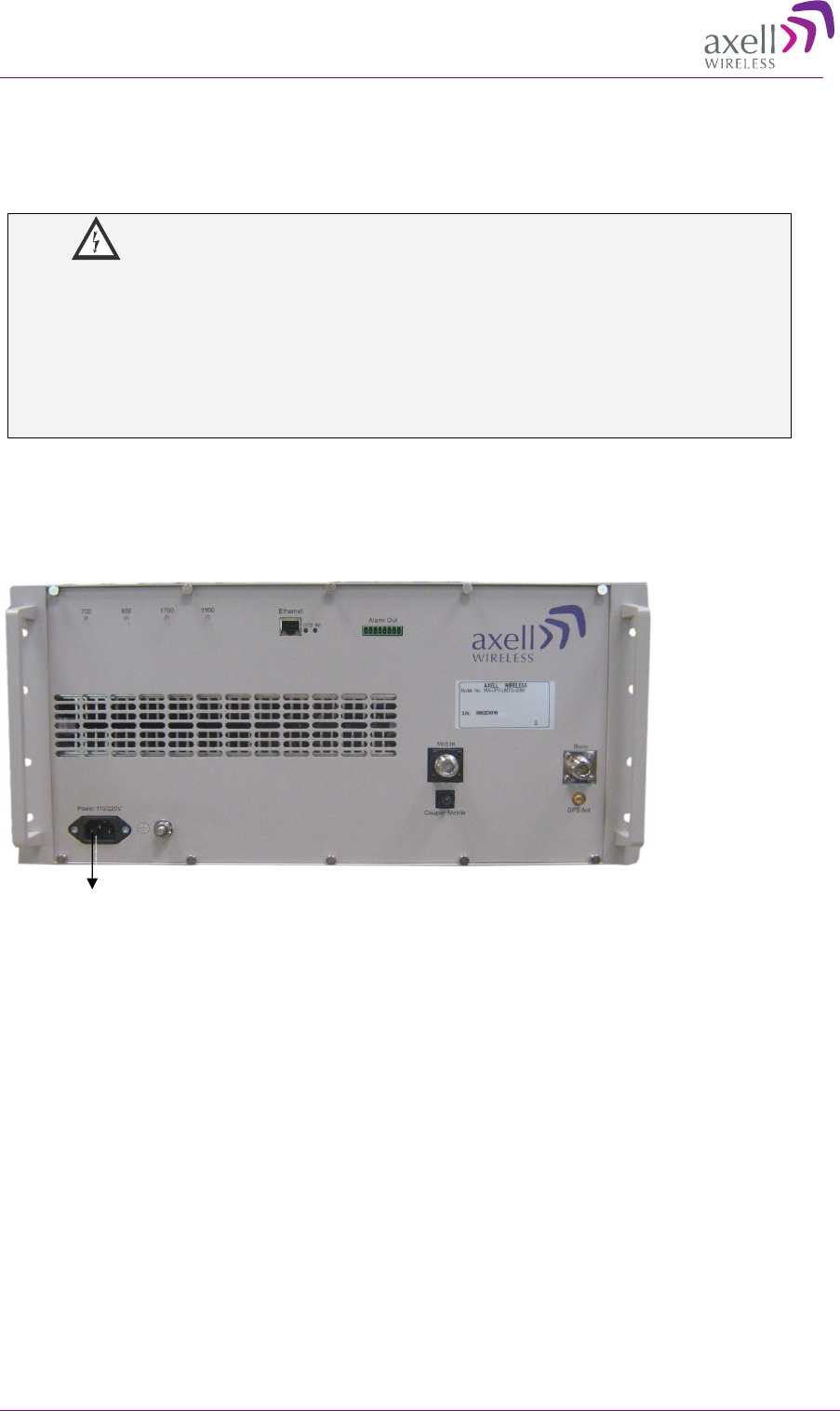
A
XELL
D-MBR-USA
R
EPEATER
PRODUCT DESCRIPTION AND USER’S MANUAL
© Axell Wireless Ltd 17
3.10 Power Connections
The Repeater operates from the power source. The power consumption is Max
320W for 3 bands, Max
400W for 4 bands
.
WARNING! Electrical Shock
A. To prevent electrical shock when installing or modifying the system power wiring,
disconnect the wiring at the power source before working with uninsulated wires or
terminals.
B. The AC input should be supplied on a 10A dual pole circuit breaker protected line
with 3mm contact gap suitable for the end application.
1. Connect the GND.
2. Locate the 110/220V AC power outlet.
3. Connect the AC power cable to the Repeaters front panel Power connector.
AC Power
connector
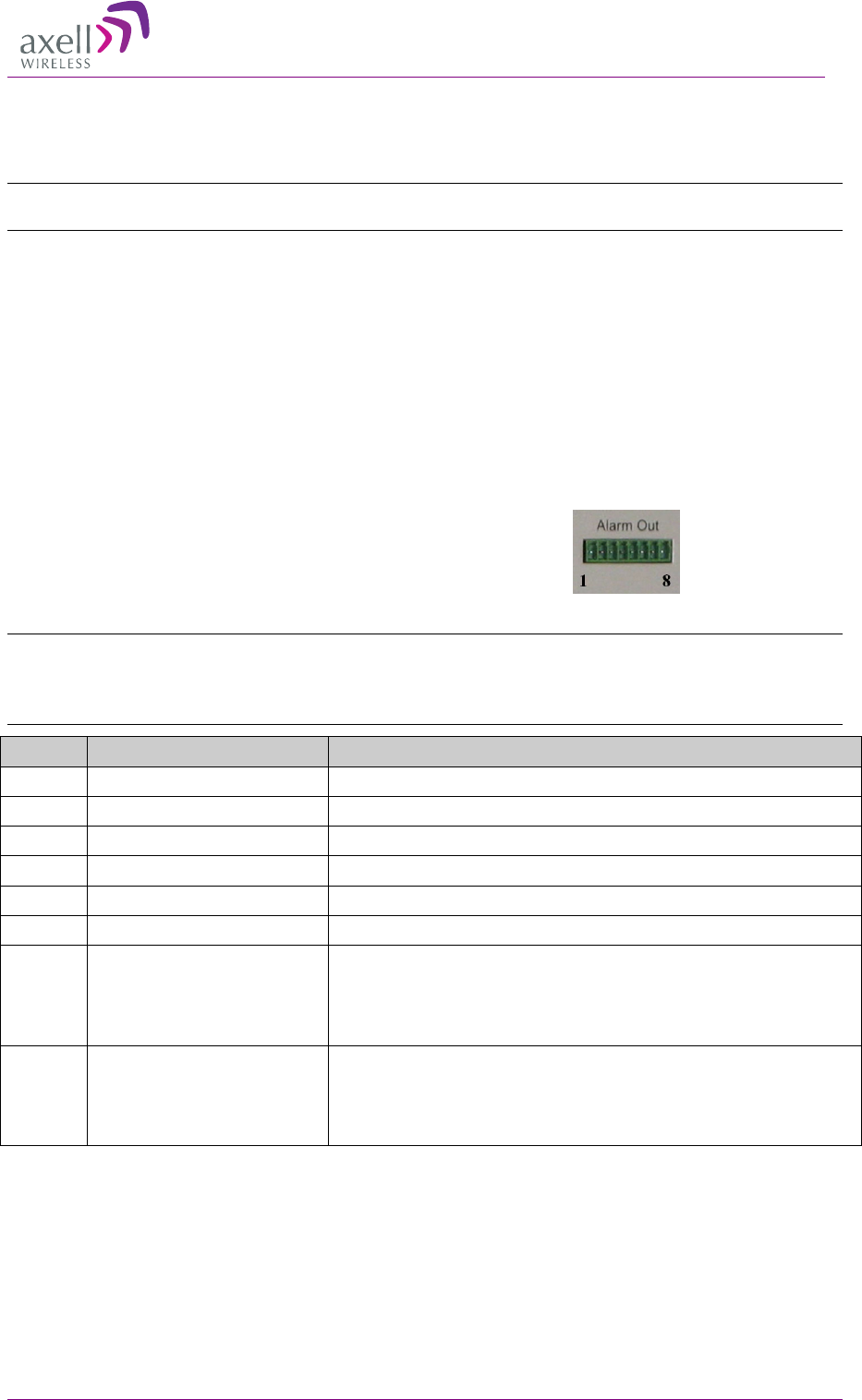
A
XELL
D-MBR-USA
R
EPEATER
PRODUCT DESCRIPTION AND USER’S MANUAL
18 Axell Wireless Ltd
3.11 Dry Contact Alarm Connections
NOTE: The dry-contact alarms may be connected at any time – before or after the Repeater is
powered-up.
This option can be used to monitor third party equipment such as air-conditioners or power supplies
that are located in the communication room.
The D-MBR-USA 8-pin Alarm port supports dry-contact alarms and system alarm monitoring from
an external source.
To activate alarms
1. Connect the alarm according to the table in this section.
2. Activate and set the alarm in the External Alarms tab, according to section
4.5.
To connect the dry contact alarm
Connect the supplied Alarm 8-pin connector (DEGSOM P.N:
15EDGK-3.5-08P-14-00A) to the D-MBR-USA ALARM port,
located on the front panel.
Note 1: The wire connections to the Alarm connector can be secured with screws (no soldering is
required).
Note 2: In order to activate an alarm, it must be configured via the Web Management application (see
4.5)
Pin No. Description Operation
1 External Alarm_1 Triggers CMU Alarm ID 1 if set in the External Alarms tab.
2 GND Ground, galvanic short to Repeater chassis.
3 External Alarm_2 Triggers CMU Alarm ID 2 if set in the External Alarms tab.
4 GND Ground, galvanic short to Repeater chassis
5 External Alarm_3 Triggers CMU Alarm ID 3 if set in the External Alarms tab.
6 Dry contact-common Dry contact relay common port
7 Dry contact relay
Normally Closed (NC)
Normally Closed – Dry contact is Normally Closed to the
relay common port. The contact is closed (shorted) during
normal Repeater operation opens when either a Major Alarm
is detected or the Repeater is switched off.
8 Dry contact relay
Normally Open (NO)
Normally Open – Dry contact is Normally Open to the relay
common port. The contact is open during normal Repeater
operation and closes when either a Major Alarm is detected or
the Repeater is switched off.
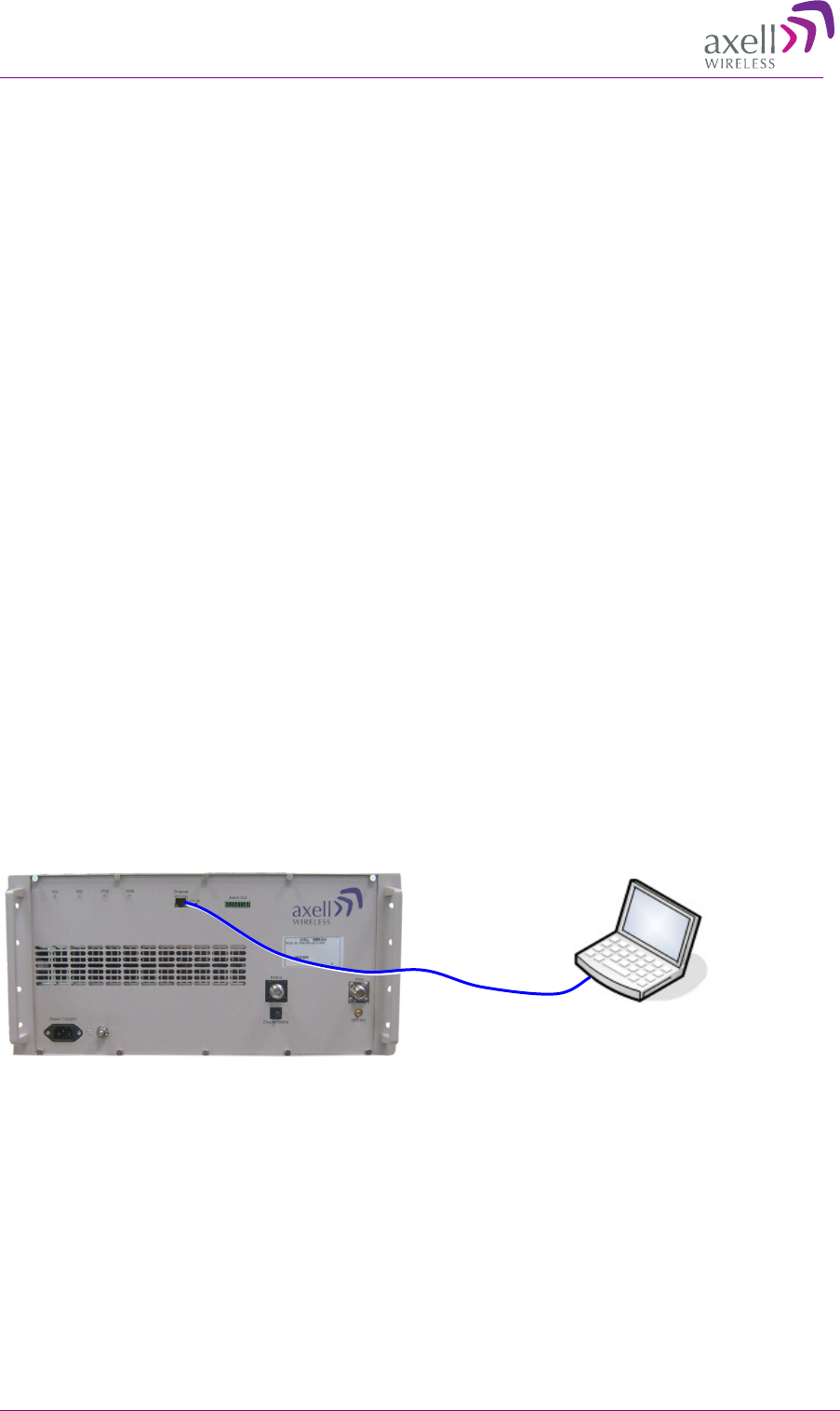
A
XELL
D-MBR-USA
R
EPEATER
PRODUCT DESCRIPTION AND USER’S MANUAL
© Axell Wireless Ltd 19
4 Initial Setup and Commissioning
This section provides the setup procedures for the D-MBR-USA Repeater. The Repeater is designed
for simple plug-and-play operation, only requiring the setup of a number of parameters (such as DL
Output Power, bandwidth, and gain) through a local Web connection and verifying that the system is
operating properly.
The setup procedure consists of the following steps:
1. Open a local Web session to the Repeater (this requires configuring the communication
parameters of the computer used).
2. If you are not familiar with the Axell Web Access application, we suggest you quickly review the
section on Navigating the Web GUI Application. It is only a couple of pages and you will find it
useful.
3. For each service, adjust the signal levels and configuring the sub-bands.
4. After the required coverage is attained for the location, verify that no Alarms are generated
before connecting to the main control center.
5. Set the Repeater time and date.
6. Configure the external alarms.
7. Configure the communication and system parameters.
4.1 Open a Local WEB Session to the Repeater
4.1.1 Connect the Repeater to the Computer
Interconnect the Repeater Ethernet port and the computer Ethernet port using the supplied Ethernet
cross-cable.
Figure 5.D-MBR-USA and Computer Ethernet Connection
4.1.2 Configure the Computer Network Parameters
Configure the computer network parameters to communicate with the Repeater. Note that the
procedure may vary slightly depending on the operating system installed on your computer. The
following procedure is for Windows 7.
To configure the computer’s network parameters:
1. Click the Start menu and choose Control Panel.
2. In the Control Panel, click Network and Internet.
Ethernet cross-cable
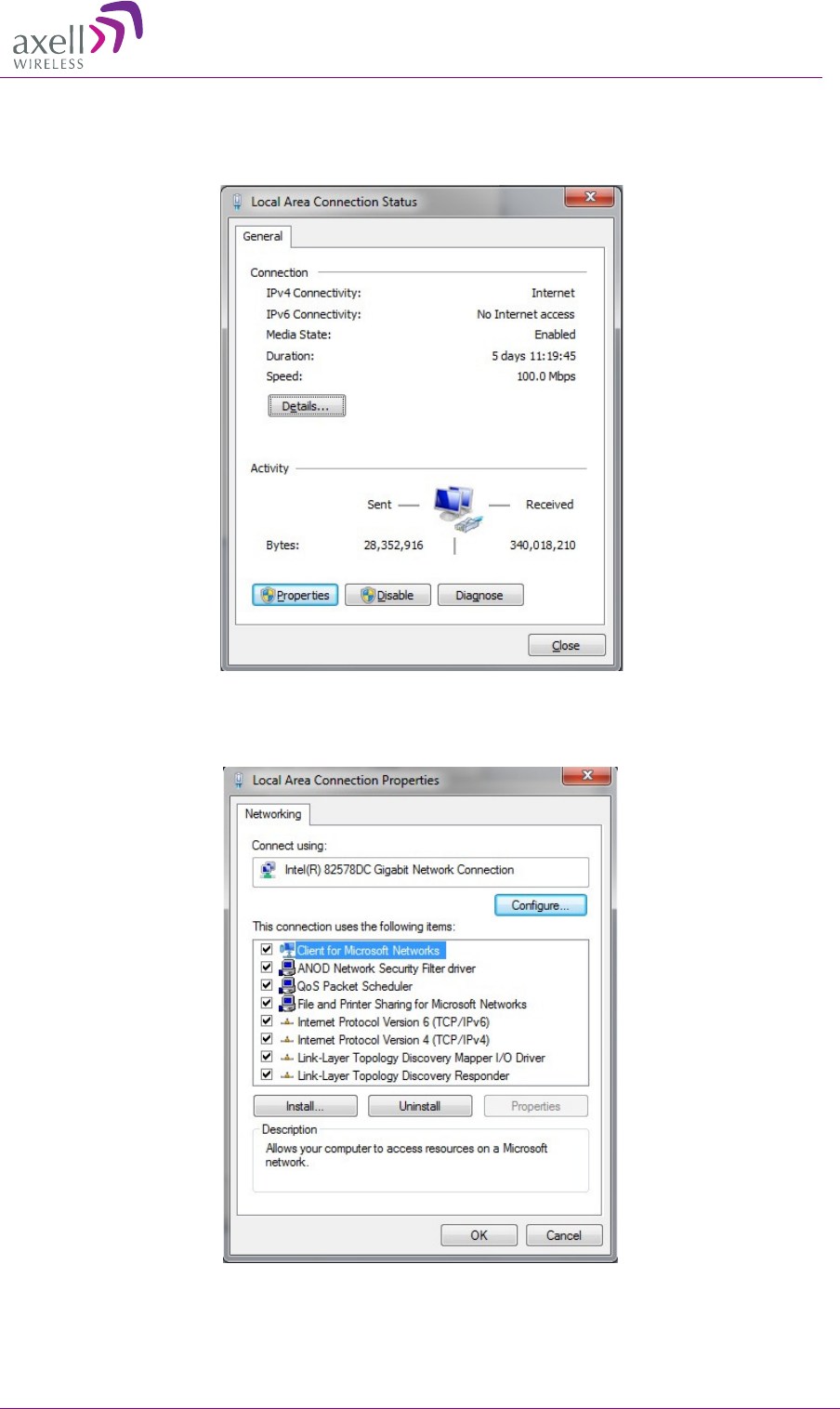
A
XELL
D-MBR-USA
R
EPEATER
PRODUCT DESCRIPTION AND USER’S MANUAL
20 Axell Wireless Ltd
3. Click Network and Sharing Center and then click Local Area Connection.
The Local Area Connections Status dialog appears with the General tab displayed by default.
4. Click the Properties button in the displayed Local Area Connection Status dialog.
5. In the Items list, double-click the Internet Protocol Version 4 (TCP*IPv4) item. The Internet
Protocol Version 4 (TCP/IPv4) Properties dialog appears.
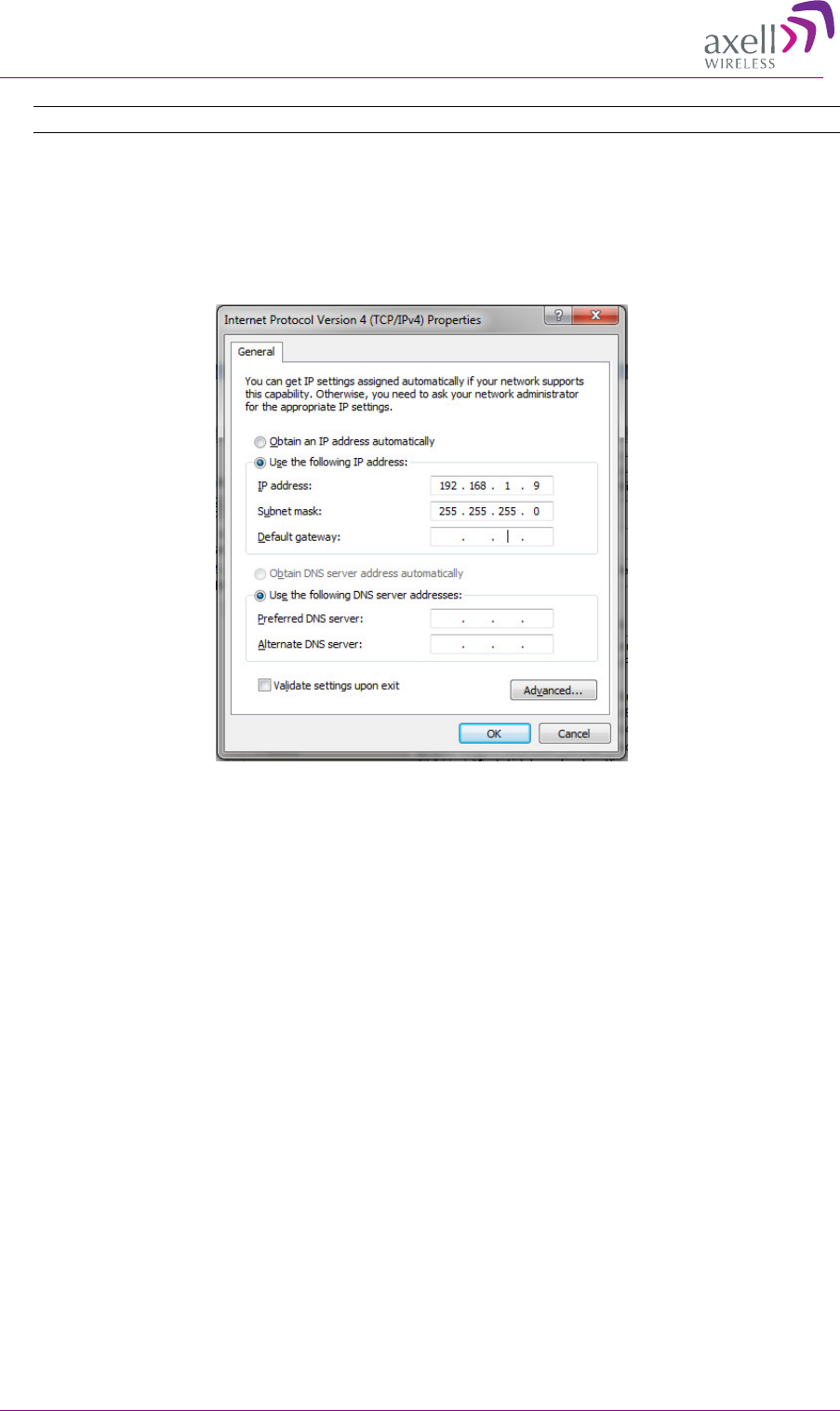
A
XELL
D-MBR-USA
R
EPEATER
PRODUCT DESCRIPTION AND USER’S MANUAL
© Axell Wireless Ltd 21
Note: The Repeater is supplied with the default IP address 192.168.1.253.
6. Assign your computer an IP address in the same subnet, in order to communicate with the unit.
• In the IP address area:
• Enter the IP address 192.168.1.x, where ‘x’ can be any number between 2 and 250
inclusive. For example, (192.168.1.9)
• Define the subnet mask as shown (255.255.255.0)
• Click OK. The computer communication parameters are now defined and you can
open a session to the Repeater.
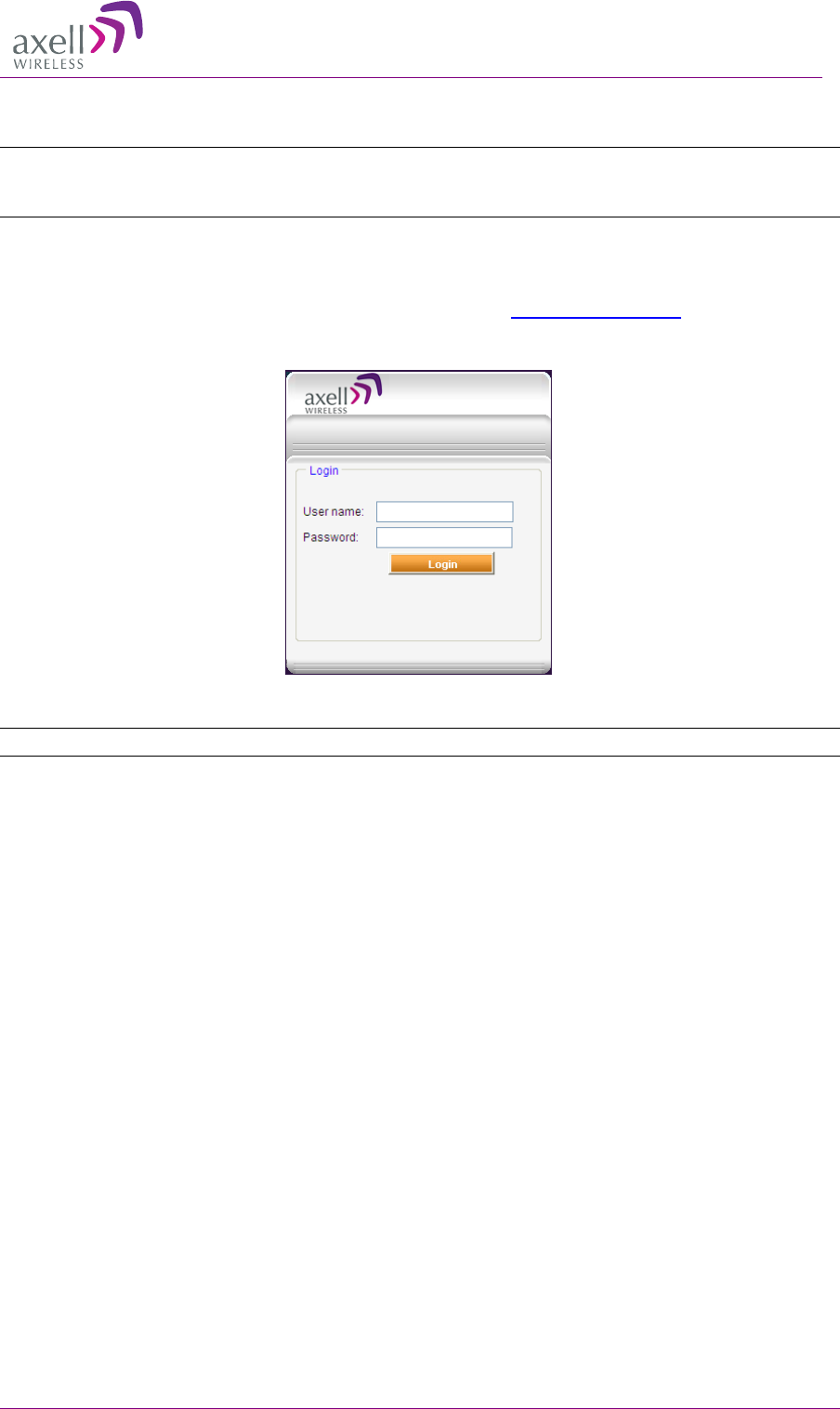
A
XELL
D-MBR-USA
R
EPEATER
PRODUCT DESCRIPTION AND USER’S MANUAL
22 Axell Wireless Ltd
4.1.3 Login to the Repeater
NOTE: The Repeater is factory assigned the address 192.168.1.253. Initial login is performed using
this address; however it is recommended to make the necessary modifications according to
information provided by your network administrator.
To login to the Repeater
1. Open one of the Flash-enabled browsers listed in the system requirements.
2. In the address line, enter the IP address of the Repeater.
http://192.168.1.253
. A session will be
established with the Repeater an the login dialog appears.
3. Type the default User Name admin and the default Password admin.
Note that both are case sensitive and must be entered with lower case letters.
4. Click Login. The application main window appears. Continue according to the following section.
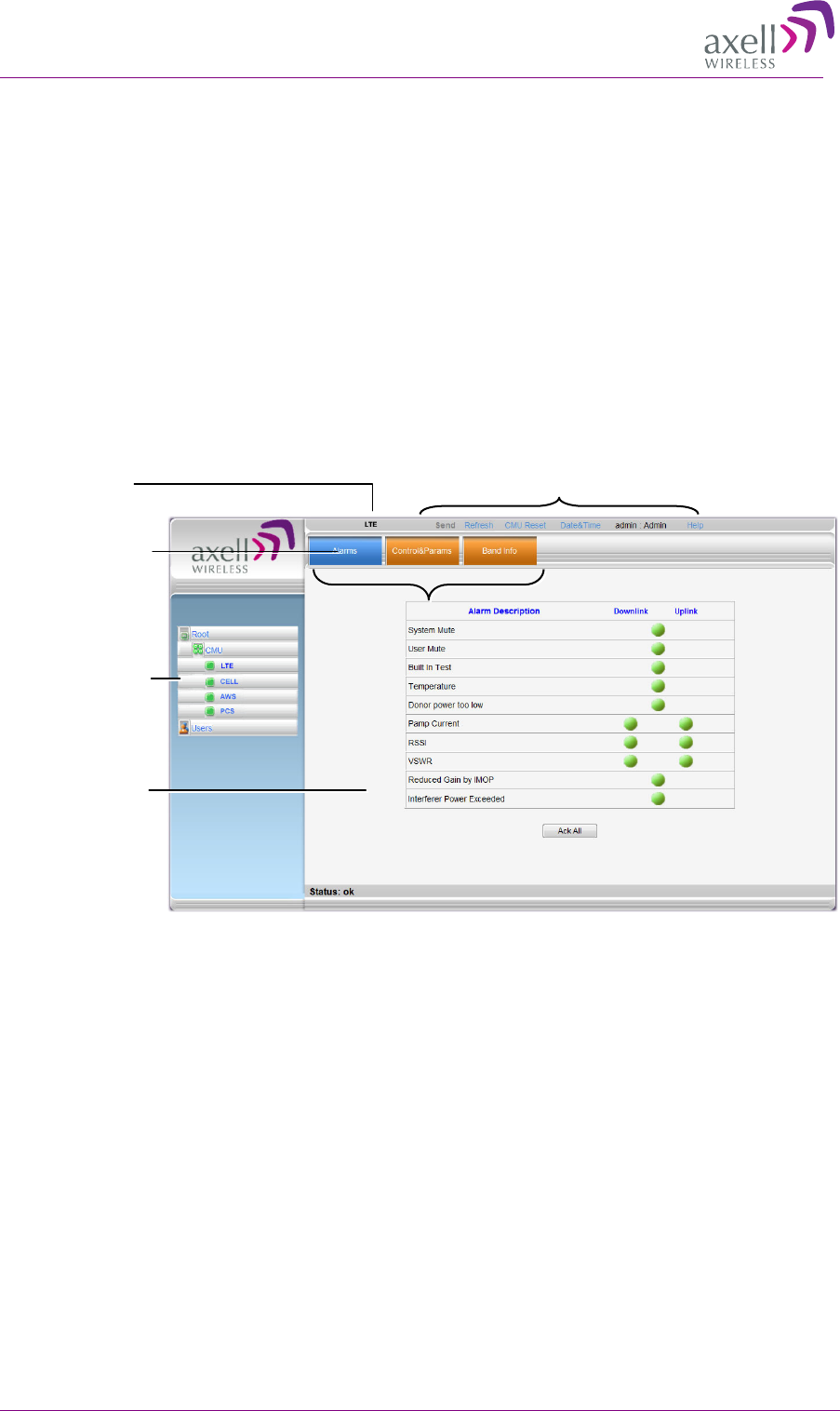
A
XELL
D-MBR-USA
R
EPEATER
PRODUCT DESCRIPTION AND USER’S MANUAL
© Axell Wireless Ltd 23
4.2 Navigating the Web GUI Application
This section describes how to navigate the Web Management application. Each service (AWS, LTE,
PCS and CELL) has a dedicated set of configuration and monitoring menus (Alarms, ConfigParams
and Band Info). The Web Access interface provides three groups of options, listed in the left side
Topology Tree items:
• CMU – management, monitoring , configuration and administration options at the Repeater
level.
• Sevice (LTE/CELL/AWS/PCS) – band level RF parameters control and monitoring options.
• Users – user definition and management options and enables changing user passwords.
The figure below shows the Alarms pane for the LTE service.
Topology Tree
Items
Pane related to
selected tree item
Tabs related to
selected Tree item
Currently
selected service
Operation Buttons
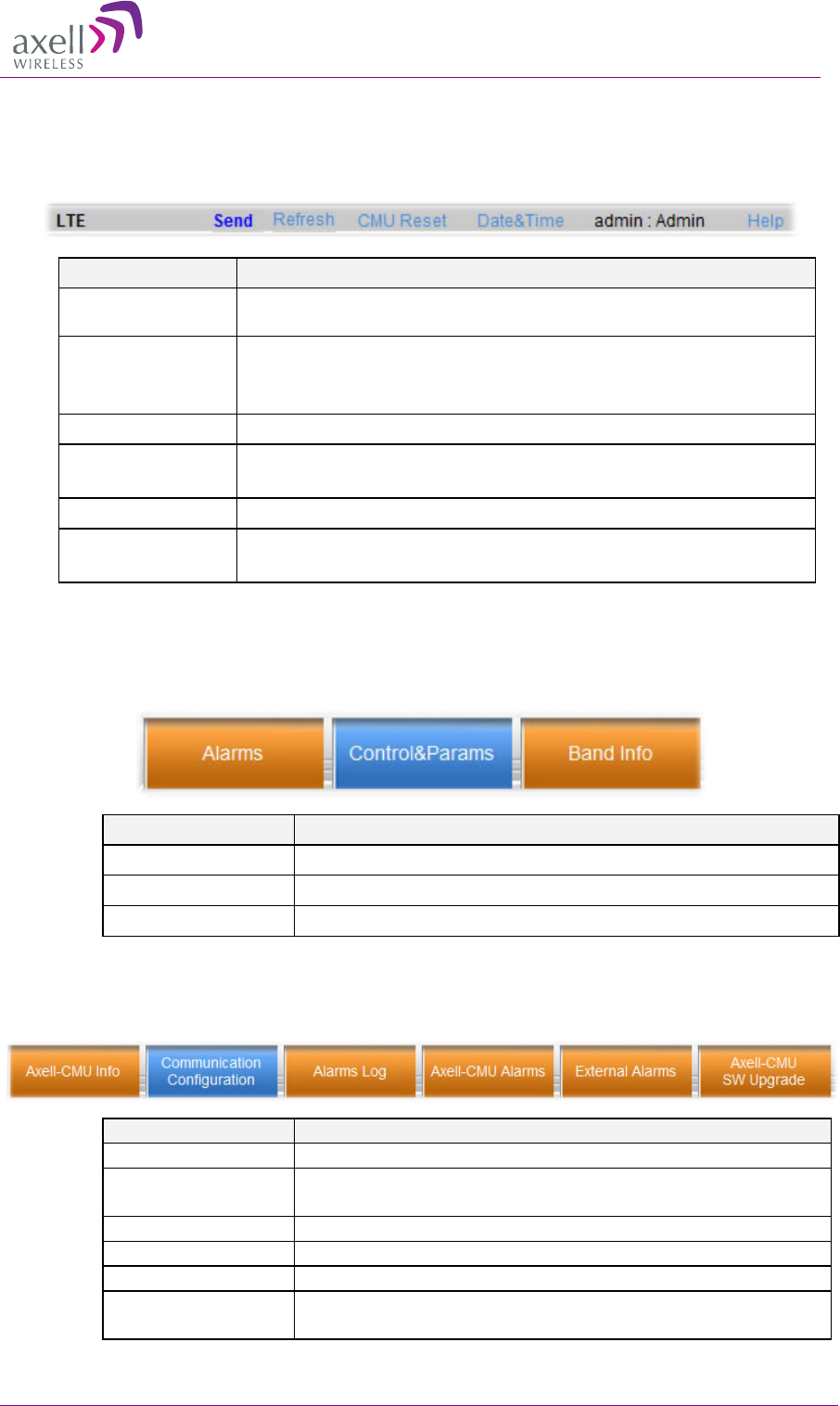
A
XELL
D-MBR-USA
R
EPEATER
PRODUCT DESCRIPTION AND USER’S MANUAL
24 Axell Wireless Ltd
4.2.1 Operation Buttons
The following Operation buttons are available.
Item Description / Values
Selected Tree Item
(i.e. LTE)
Shows the currently selected topology tree item.
Values: CMU, Band (e.g. LTE), Users
Send Click after completing the new data input and values update in any
screen in order to insert the new values into the Repeater, and
implement the changes
Refresh Click to refresh the current screen and update the displayed data
CMU Reset Click to reset the Web Access application, in case of failure or
display problems
Date and Time Provides access to date and clock settings.
Help Click Help to display an e-guide line for the system operation. This
Help is general by its nature and some features may not be included.
4.2.2 Service Pane and Tabs
The upper area of each selected pane shows the tabs corresponding to that pane.
Item Description / Values
Alarms Band level alarms
Control and Params RF settings and configuration of sub-channels.
Band Info Shows band related identification information
4.2.3 CMU Pane and Tabs
When the CMU item is selected in the Topology Tree, the following menu items are available.
Item Description / Values
Axell-CMU Info Repeater identification, SW versions.
Communication
Configuration
Used to set IP, SNMP and SMS notification, modem
communication parameters and AEM related settings.
Alarms Log Log of previous and current system level alarms
Axell-CMU Alarms Current system alarms
External Alarms Used to enable and configure any connected external alarms.
Axell-CMU SW
Upgrade
Options for CMU software upgrade.

A
XELL
D-MBR-USA
R
EPEATER
PRODUCT DESCRIPTION AND USER’S MANUAL
© Axell Wireless Ltd 25
4.3 Signal Levels and Channel Configuration
This section provides a description of the RF Gain setting criteria (set via the Controls and Params
Pane) and a step-by-step procedure of the signal level and channel configuration procedure.
4.3.1 RF Gain Setting Criteria
The RF Gain is set automatically by the Repeater’s SALC function (section
0). The function sets the
optimum gain without exceeding the isolation limit.
The gain range is up to 80dB for all bands and is set by default to its maximum value of 80dB.
The gain will then be modified automatically to its optimum value by the SALC mechanism. This
mechanism performs gradual learning of traffic load characteristics and adjusts the Repeater RF Gain
accordingly. (See section
0 for more information on the SALC mechanism).
4.3.2 Adjusting the Signal Levels and Configuring Channels
The Control and Params (parameters) window is used to configure up to 8 channels for each band
and the RF parameters. This section describes each of the fields.
Up to 8 sub-bands referred to as filters can be defined, where each sub-band is individually defined
by setting the following:
• Bandwidth (start and stop frequency) - each sub-band can be set over specific bandwidths. For
example, LTE sub-channels can be defined over the full (upper and lower) LTE for the following
bandwidths: 1.4MHz, 3MHz, 5MHz, 10MHz or 15MHz
• Maximum power
• Maximum gain
• Gain delta
The defined sub-bands are displayed in the lower part of the screen for reference.
Refer to the Band Info tab for information on the relevant bandwidths for each frequency. If you
attempt to define a bandwidth (block) that is not appropriate for the selected frequency, the
appropriate notification will appear.
Note that the number of supported channels depends on the technology as indicated below.
Filter BW Technology Frequency bands Number of
FPGA Resources
2.5Mhz-20MHz
( in 2.5MHz steps)
CDMA 850/1700/1900 MHz 2
1.5,2.5,11Mhz CDMA 850MHz 2
1.4,3,5,10,15,20Mhz LTE 700/850/1700/1900 MHz 2
To adjust the signal levels and configure the channels
1. In the left pane (Topology Tree), select the band (LTE, CELL, etc.) whose sub-bands are to be
configured.
2. Click the Control and Params tab. The relevant window appears.
The window is divided into the following areas:
• System – overall parameters for the selected service.
• Filter definitions – used to define up to 8 sub-bands and their RF parameters.
• Sub-bands view – graphical display of defined sub-bands for the selected service.
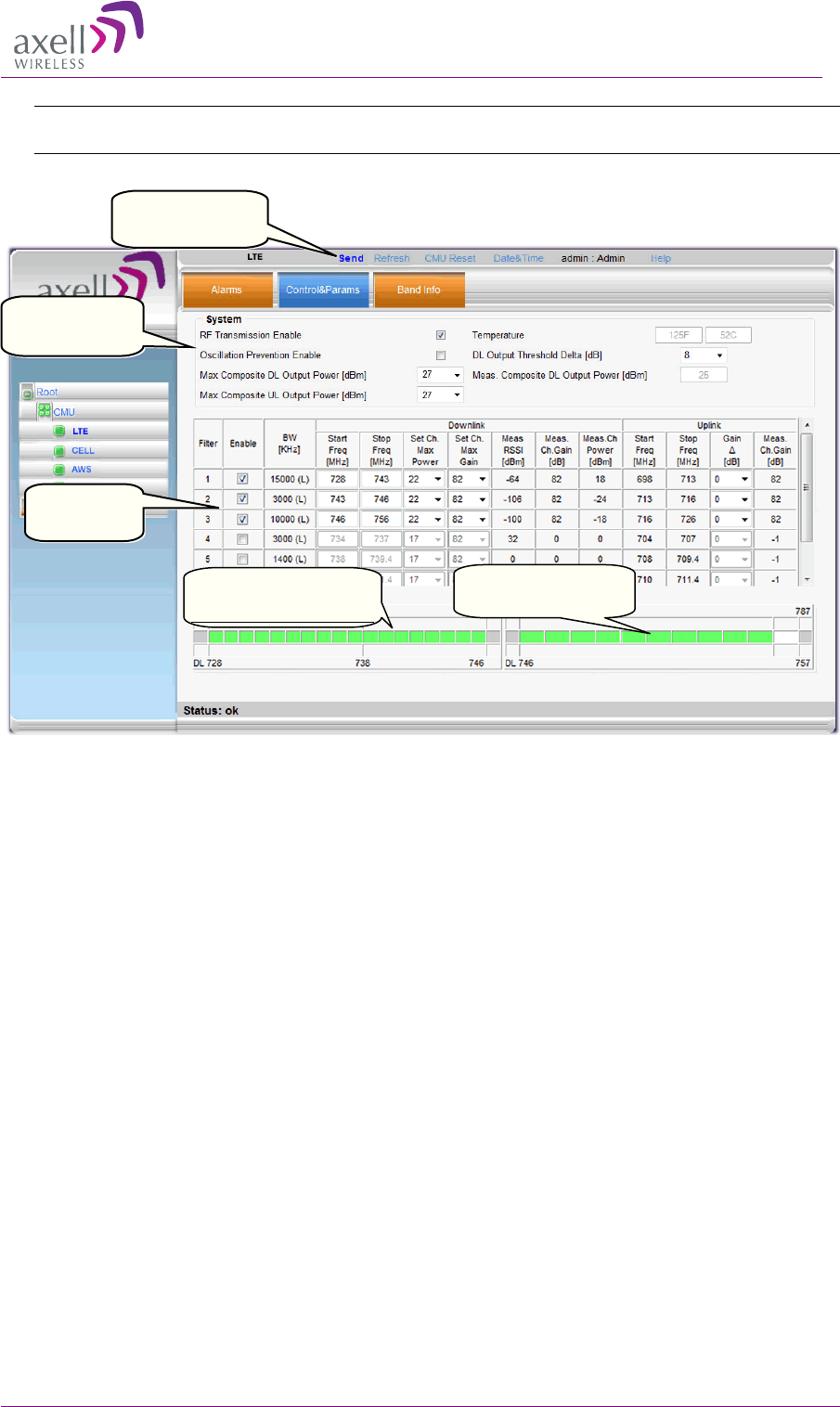
A
XELL
D-MBR-USA
R
EPEATER
PRODUCT DESCRIPTION AND USER’S MANUAL
26 Axell Wireless Ltd
Note: The following pane shows the LTE Control and Params tab (other band tabs are similar,
except for the parameter values).
Figure
4-6. Params and Control Tab
3. In the System area:
• Verify that the RF Transmission Enable parameter is checked. (This parameter is
used to disable (and re-enable) RF transmission for the band.)
• Set the user defined maximum output signal level for this band by defining the Max
Composite DL Output Power according to your site requirements (click Send). (The
Measured Composite DL Output Power is displayed in the adjacent field.)
If the Max Composite DL Output Power composite output power exceeds the defined
value, the Smart ALC feature begins working.
• Set the Max Composite UL Output Power according to your site requirements.
This is the maximum output signal level for this band.
Service level
parameters
sub-band
definitions
Click
Send
with
each change
Defined
Lower A,B,C
band channels
Defined
Upper C
band channels

A
XELL
D-MBR-USA
R
EPEATER
PRODUCT DESCRIPTION AND USER’S MANUAL
© Axell Wireless Ltd 27
Additional parameters (not required for initial setup) are:
•
Oscillation Prevention Enable - Enables oscillation detection mechanism that
maintains repeater functionality.
• Temperature - Displays Repeater ambient temperature.
• DL Output Threshold Delta (dB) - the delta from the set Composite Output Power,
below which the alarm 'Donor power is too low' is activated.
For example, if the DL Output Threshold value is set to 8dB, when the Measured
Composite DL output power is 8dB less than the set Composite Output Power, an alarm
is generated.
• Meas. Composite DL Output Power – displays the currently measured output signal
level.
4. Configure each required sub-band (Filter) as follows and then click Send:
• Check the Enable box to activate the sub-band. The configuration parameters in that
row will be available.
• Set the Start and Stop DL Frequency (MHz) in the corresponding fields. (The UL
frequencies are automatically defined according to the DL values).
The defined BW will be displayed in the BW KHz column (to the left of the Start
Frequency).
Be sure to choose Start/Stop values that provide the appropriate BW (i.e. for LTE
1.4MHz, 3MHz, 5MHz, 10MHz or 15MHz).
• Set the (Downlink) Max Gain as follows: by default, the MAX Gain (DL) parameter
is set to its highest level (82dB). Change the Channel Max Gain (DL) according to
the measured/calculated input power and isolation measurements.
The recommended Maximum Gain setting is approximately 15 dB less than the isolation
between the service and donor antennas.
5. If the site NOISE LEVEL is high enough to cause interference, adjust the noise level as follows:
• Adjust the Gain Delta parameter – this sets the delta between the uplink and
downlink gain (so the uplink gain is relatively lower than the downlink gain.
• Click Send. The defined sub-band will appear in the display in the appropriate area.
• Repeat the procedure until the desired coverage is achieved.
6. More information on parameters for the selected sub-band:
• DL Set Ch. Max. Gain Sets the power for the antennas. The value is about 15 dB
less than the isolation between the donor antenna and the mobile antenna.
The Value defined in the DL path is reflected in the UL path, however to define different
UL and DL path values the Gain Delta parameter is used and its defined value is added
to the UL value.
• DL Measured RSSI - measured DL signal.
• DL Measured Ch. Gain - measured DL Gain (dB) for the selected sub-band.
• DL Measured Ch. Power - measured Power (dBm) for the selected sub-band.
• UL Gain ∆ - used for noise control. Sets the difference between UL and DL gain.
• UL Measured Ch. Gain - measured UL Gain (dB) for the selected sub-band.
7. Click Send (top window area option).
8. After the channels have been configured and the required coverage is attained for the location,
verify that no Alarms are generated:
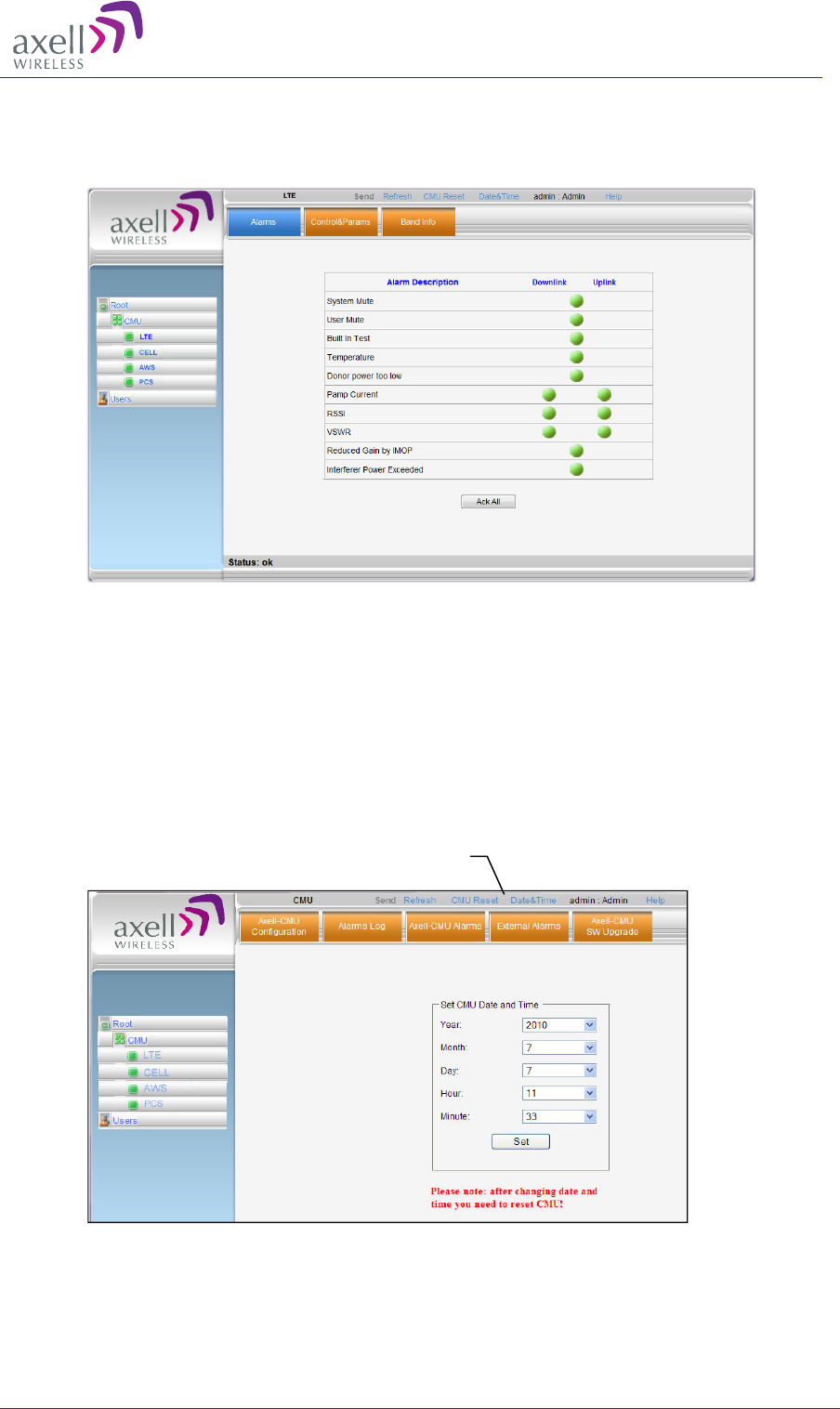
A
XELL
D-MBR-USA
R
EPEATER
PRODUCT DESCRIPTION AND USER’S MANUAL
28 Axell Wireless Ltd
• Click the Alarms tab
• Verify that all the indicators are GREEN in the Alarms tab.
4.4 Setting Date and Time
It is important to set the correct date and time on the unit since this provides the timestamp for each
logged event and alarm.
To set the Repeaters date and time
1. Click on CMU in the tree pane.
2. Click on Date & Time in the menu bar. The following dialog appears.
3. Set the date and time parameters and click on Set.
4. Click CMU Reset.
CMU Reset
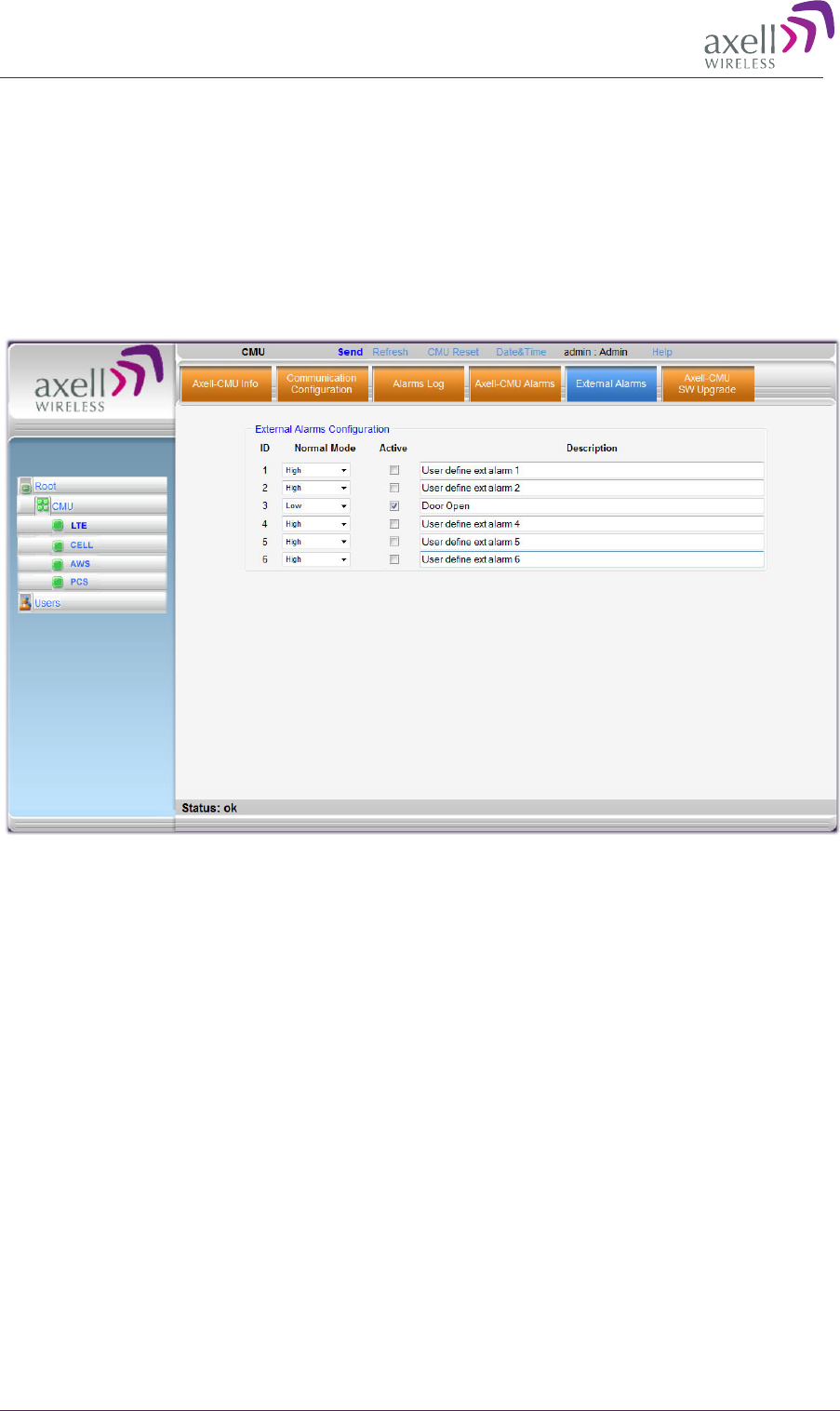
A
XELL
D-MBR-USA
R
EPEATER
PRODUCT DESCRIPTION AND USER’S MANUAL
© Axell Wireless Ltd 29
4.5 Configuring External Alarms
Any connected alarms (section
3.11) must be enabled and configured according to the instructions
provided in this section.
To configure external alarms
1. Click on CMU in the tree pane.
2. Click the External Alarms tab. The following dialog appears.
3. For each connected alarm:
• Checkmark the Active checkbox.
• Set the alarm Normal Mode as High or Low.
• In the Description field, assign the alarm an identifiable name.
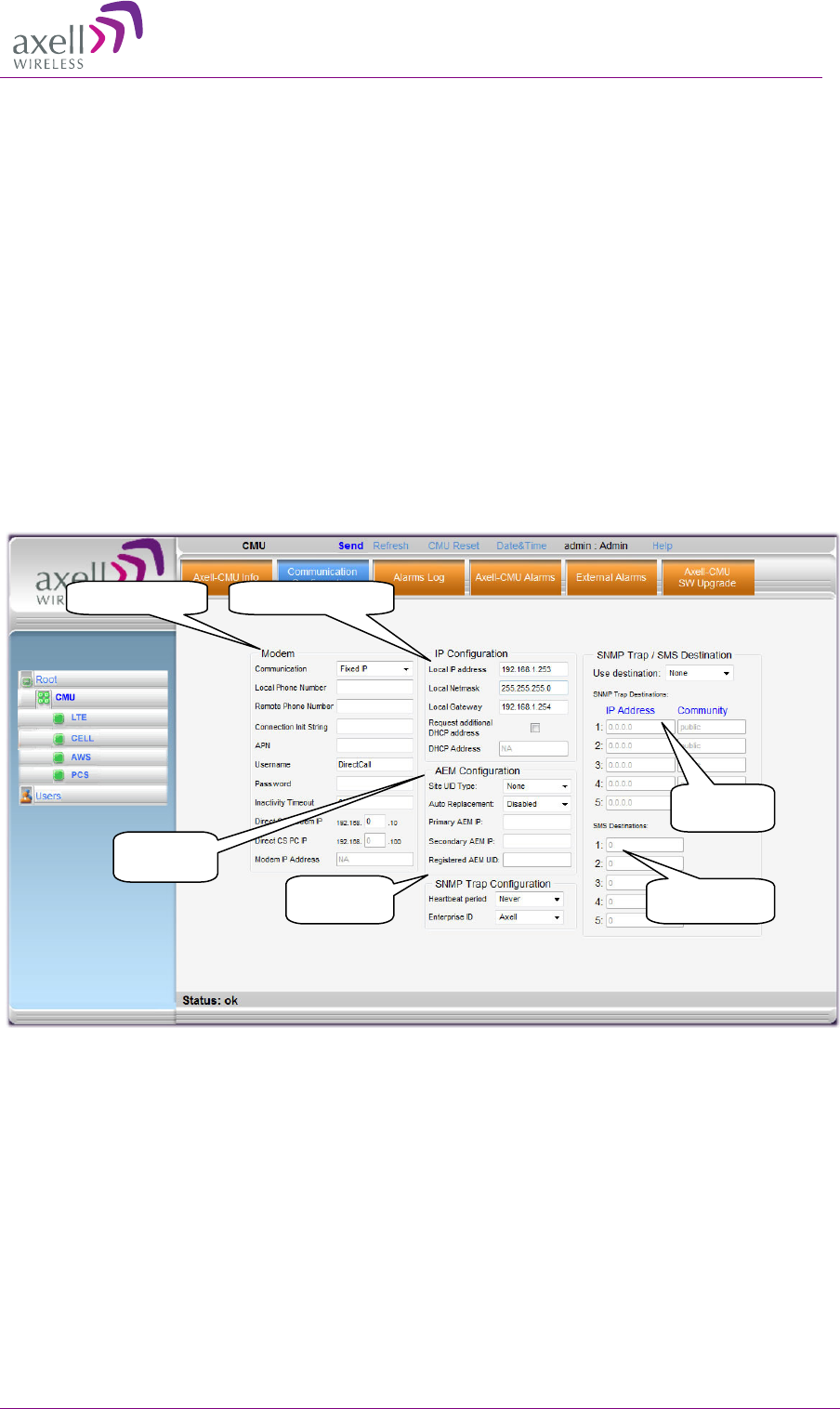
A
XELL
D-MBR-USA
R
EPEATER
PRODUCT DESCRIPTION AND USER’S MANUAL
30 Axell Wireless Ltd
4.6 Communication and System Parameters
The Communication Configuration tab is used to define the IP parameters, modem parameters, and
trap notification (SNMP or SMS).
This section describes how to access the dialog. The following sub-sections provide detailed
information on each configuration option.
4.6.1 The Communication Configuration Tab
To access the Communication Configuration Tab
In the left tree pane, click CMU. From the available tabs in the work area, choose the
Communication Configuration tab.
The various options are grouped into dedicated areas as illustrated below.
4.6.2 IP Address Configuration
The Repeater supports both Static and DHCP addresses. A unique technology enables applying both
types to the same Ethernet port. Both addresses may enable local and remote management.
• Local IP Address – Static IP assigned by the user to the system. The default Static IP address is
192.168.1.253. It is highly recommended to preserve this setup. In case of a change, make sure
you record the newly assign IP.
• DHCP Address – address assigned by DHCP server – used for remote management via an
Ethernet connection.
IP Address settings
Modem parameters
SNMP IP
destinations
Trap sending
frequency
SMS destinations
mobile numbers
AEM
configuration
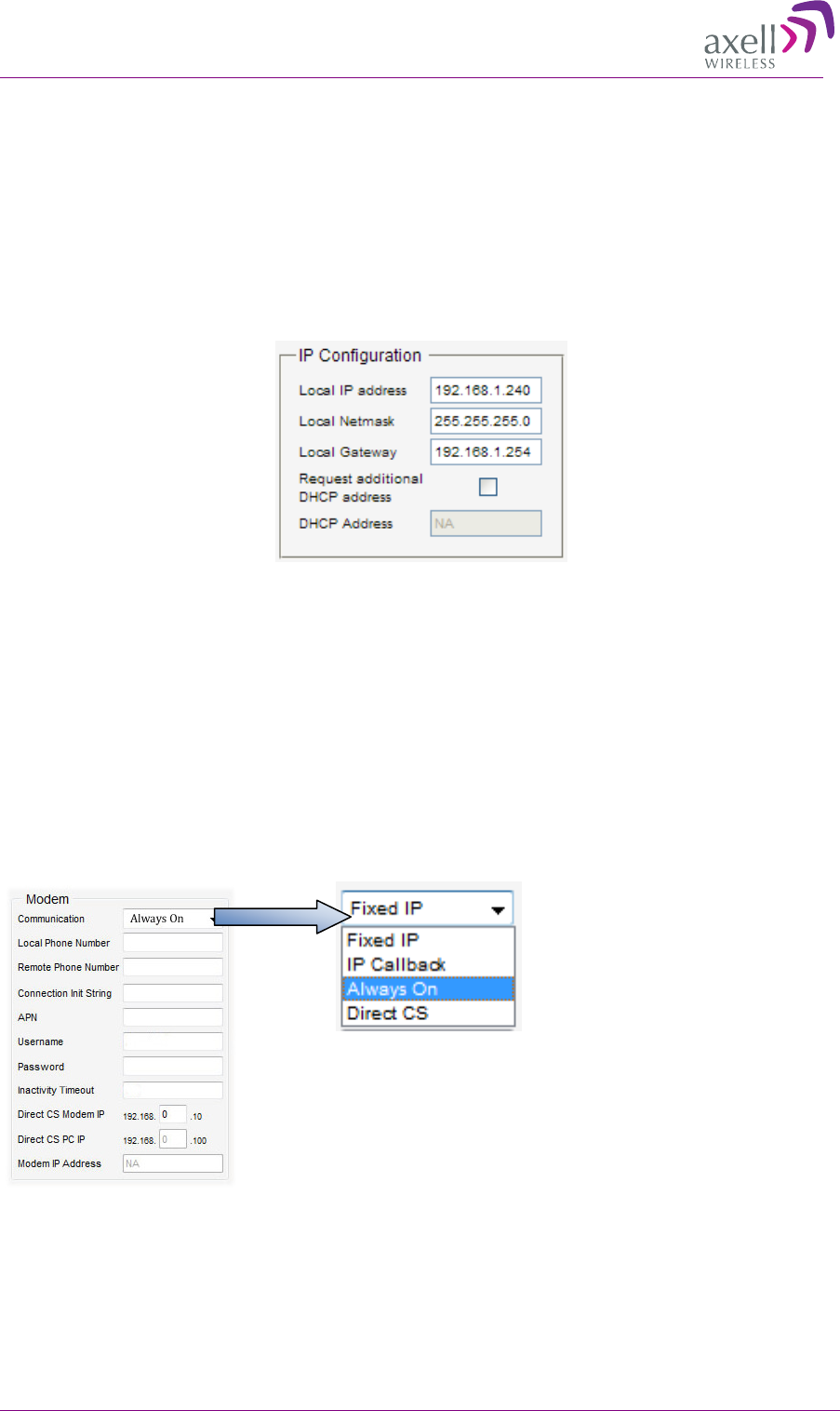
A
XELL
D-MBR-USA
R
EPEATER
PRODUCT DESCRIPTION AND USER’S MANUAL
© Axell Wireless Ltd 31
To assign the unit IP address
1. Access the CMU Configuration tab according to section
4.6.1.
2. To assign the unit addresses:
• Local address - in the IP Configuration area, assign the unit the IP address, Netmask
and Gateway parameters provided by your system administrator.
• DHCP server address – checkmark the option Request Additional DHCP Address.
The assigned address can be seen in the DHCP Address field.
4.7 Modem Communication Setup
This section describes how to access the modem communication settings. The following sections
describe how to configure for specific communication requirements: packet switch (GSM/GPRS or
CDMA), Direct Circuit Switch (GSM/GPRS only) or other settings.
To access the modem settings
Click the Communication Configuration tab and in the Modem area choose Communication field
as illustrated below (the options are described in the following table).
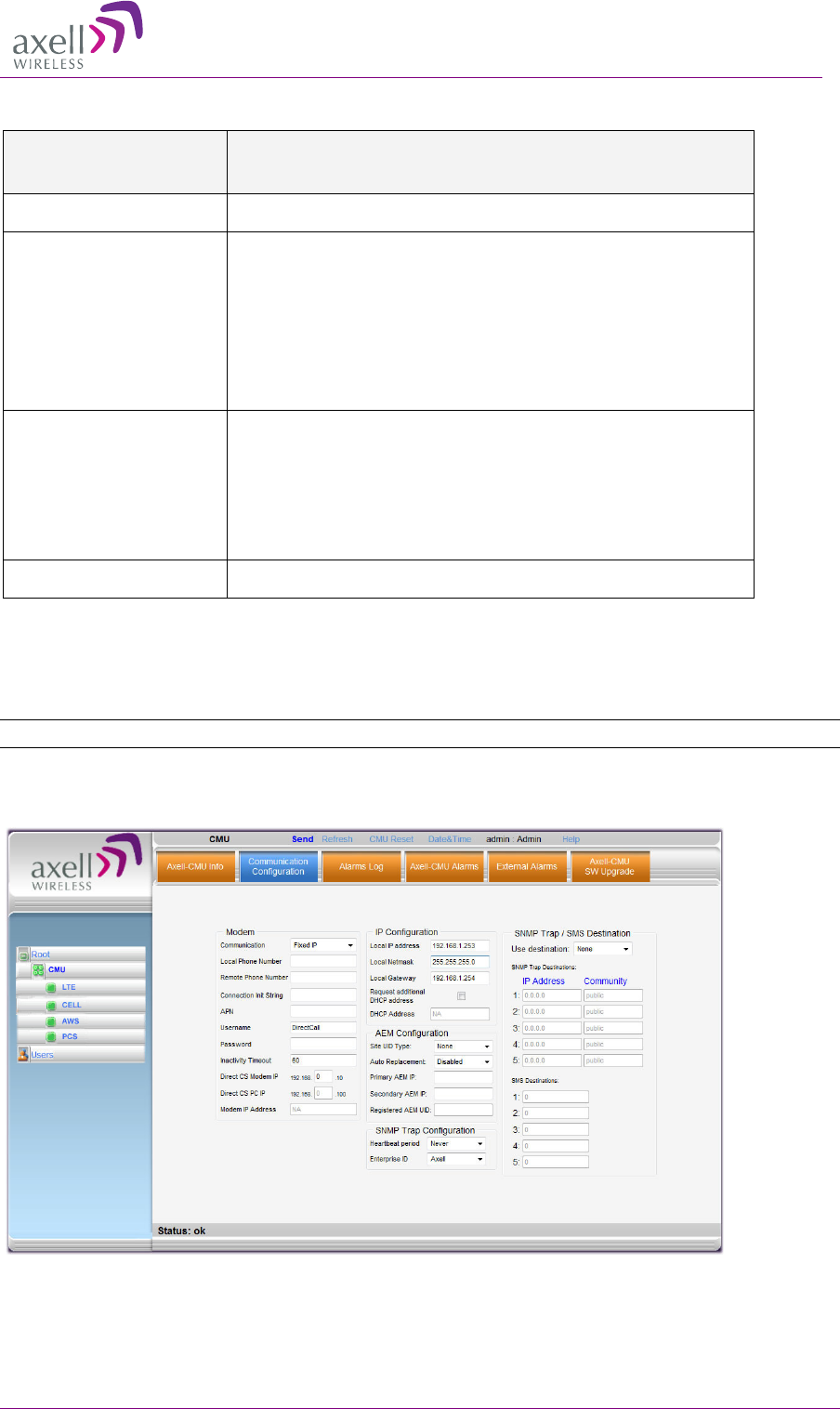
A
XELL
D-MBR-USA
R
EPEATER
PRODUCT DESCRIPTION AND USER’S MANUAL
32 Axell Wireless Ltd
In the communication
field, select …
For this communication mode.
Fixed IP. Modem OFF
Always ON.
Packet Switch mode: refer to the GSM/GPRS or CDMA
sections below – according to your modem.
Additional parameters: define according to your operator
requirements.
Note: After the modem connects to the network, the Modem
IP Address is displayed.
Direct CS.
Direct Circuit Switch. (See
4.7.3)
Additional parameters: Also (depending on the configuration
required by your operator), define the Connection Init string,
User Name, Password and Direct CS Modem IP (an internal
address used for Web surfing.
IP Callback Special mode for specific installation types.
4.7.1 GSM/GPRS Communication
For GSM/GPRS communication, GSM/GPRS modems are installed. These modems support
both a Packet Switch and a Direct Circuit Switch connection.
NOTE: It is assumed that the SIM card is already installed according to section
3.6.
To define the modem parameters
1. Click CMU in the left tree pane and select the Communication Configuration pane.
2. In the Modem area, set the Communication mode as Always ON.
3. Define any additional parameters as required by your operator.
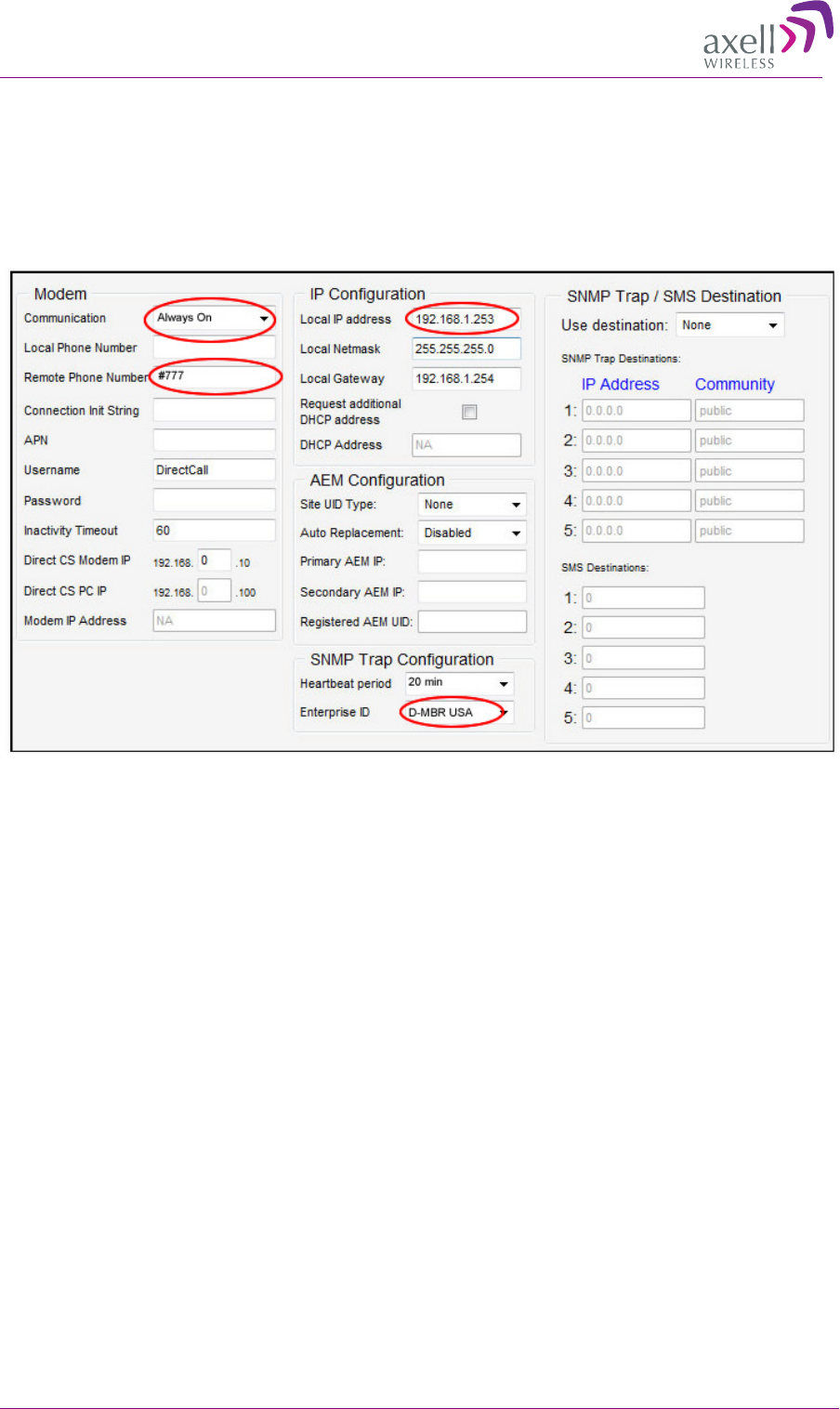
A
XELL
D-MBR-USA
R
EPEATER
PRODUCT DESCRIPTION AND USER’S MANUAL
© Axell Wireless Ltd 33
4.7.2 Verizon CDMA Modem Communication Configuration
Configure the modem parameters and activate the modem in the Verizon network.
4.7.2.1 Configuring the Modem Parameters
To configure for a CDMA modem
1. In the Modem area above, verify that:
• Modem Communication = Always On
• Remote Phone no. = #777
• Modem Init String = empty field (blank)
• Enterprise ID = Verizon.
2. Activate the modem in the Verizon network according to the following section.
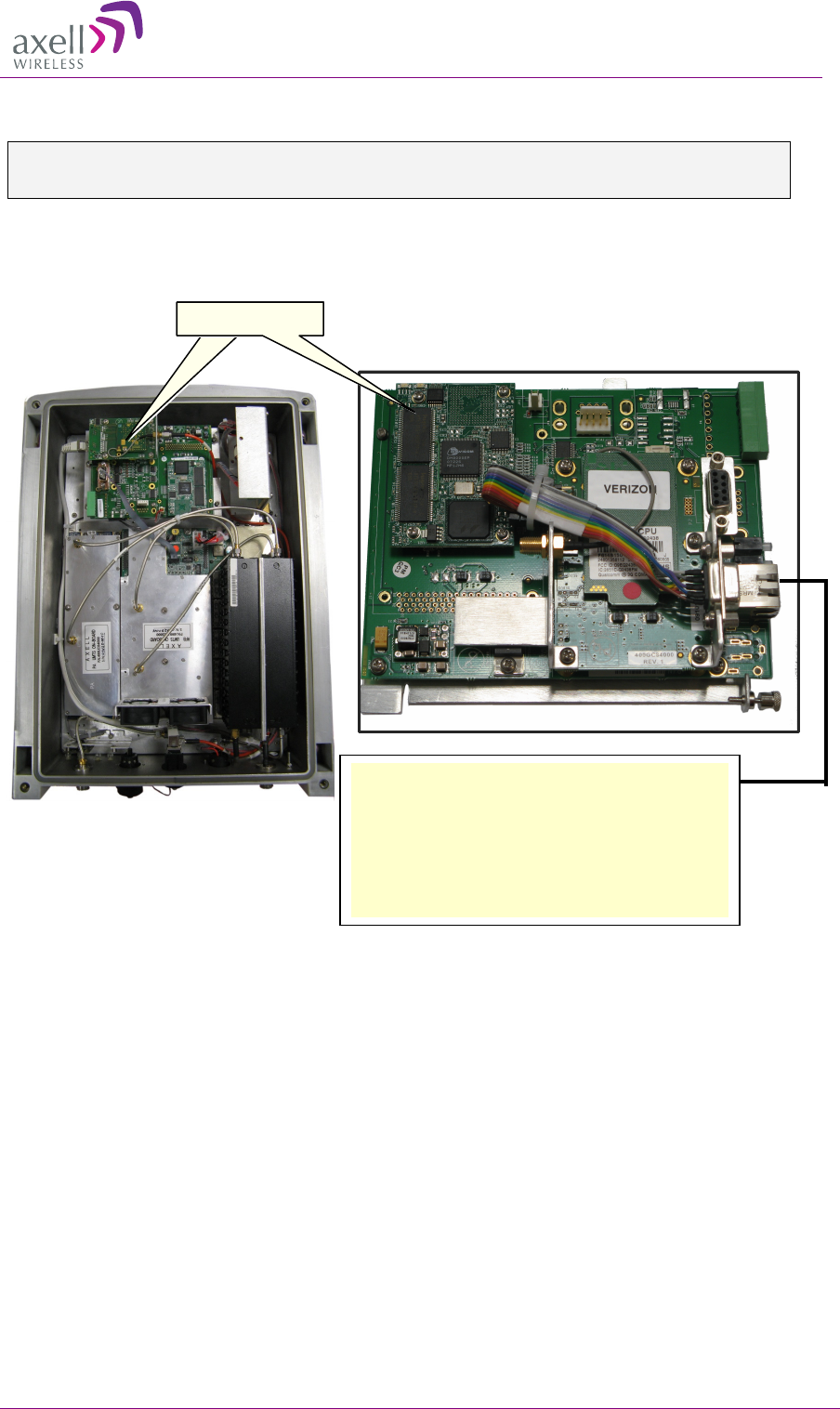
A
XELL
D-MBR-USA
R
EPEATER
PRODUCT DESCRIPTION AND USER’S MANUAL
34 Axell Wireless Ltd
4.7.2.2 Activating the modem in the Verizon network
WARNING!!! Settings of the Modem are sensitive to changes. Insert values and
parameters with particular care in order to enable the remote connection.
Below is the activation procedure for the modem in the Verizon Wireless Network.
1. Open the Repeater and connect the RS-232 cable (provided in the accessory kit) to the CMU
card RS-232 connector.
2. Open HyperTerminal with (or eqvivalent program)
3. Set connection speed to 115,200, no flow control.
4. Type AT and you should get a response OK.
5. Use the command ATD*22899; (ensure there is a semi-colon “;” after the dial string, otherwise
you will make a circuit data call). This will start your OTASP (Over-The-Air, Service
Provisioning) session.
The following messages should be displayed:
• +WOT1: “Programming in Progress”
• +WOTS: “SPL unlocked”
• +WOTP: “PRL download OK”
• +WOTM: “MDM download OK”
• +WOTC: “Commit successful”
• +WOT2: “Programming Successful!”
CDMA Modem
Connect supplied RS232 cable to RS-232
connector.
After completing the modem setup, be sure
to remove the cable CAREFULLY so as to
avoid damaging the adjacent Ethernet
connector.
CDMA Modem

A
XELL
D-MBR-USA
R
EPEATER
PRODUCT DESCRIPTION AND USER’S MANUAL
© Axell Wireless Ltd 35
IMPORTANT* After programming, remove the RS-232 cable for proper modem function on
the Verizon network.
6. After a few minutes, a Modem IP Address should appear on the CMU GUI screen. This indicates
the modem is functioning on the Verizon Network. The module is then set up for both voice and
data.
4.7.3 Direct Circuit Switch Connection
A. On the Repeater, set the Repeater Modem parameters (above) as follows:
• Communication - Direct CS
• To provide security, set the User Name and Password for the repeater (the same User
Name and Password will be defined on the dial-up connection).
• You may modify (optional) the Direct CS Modem IP – this is the Web address used
to open a Repeater session. Otherwise, the default displayed value can be used.
B. On your computer, set up a dial-up connection as follows:
1. Via Network Connections, create a Dial-up connection on your computer (Connect using a dial-
up modem). The procedure may vary slightly depending on your Operating System.
2. Define the parameters as follows:
• ISP connection name – user defined, recognizable name for this connection for future
reference.
• Phone Number – the number corresponding to the SIM card installed on the Repeater.
• User Name and Password – the User Name and Password (if assigned) that you
allocated in the Modem parameters in the Communication dialog (see previous
section).
C. Open a session to the Repeater:
1. On your computer, click the relevant dial-up connection item or the icon, to open a dial-up route
to the Repeater.
2. Open a Web Browser and enter the Direct CS Modem IP that is defined in the Modem
parameters on your Repeater. A session will be opened to the Repeater.
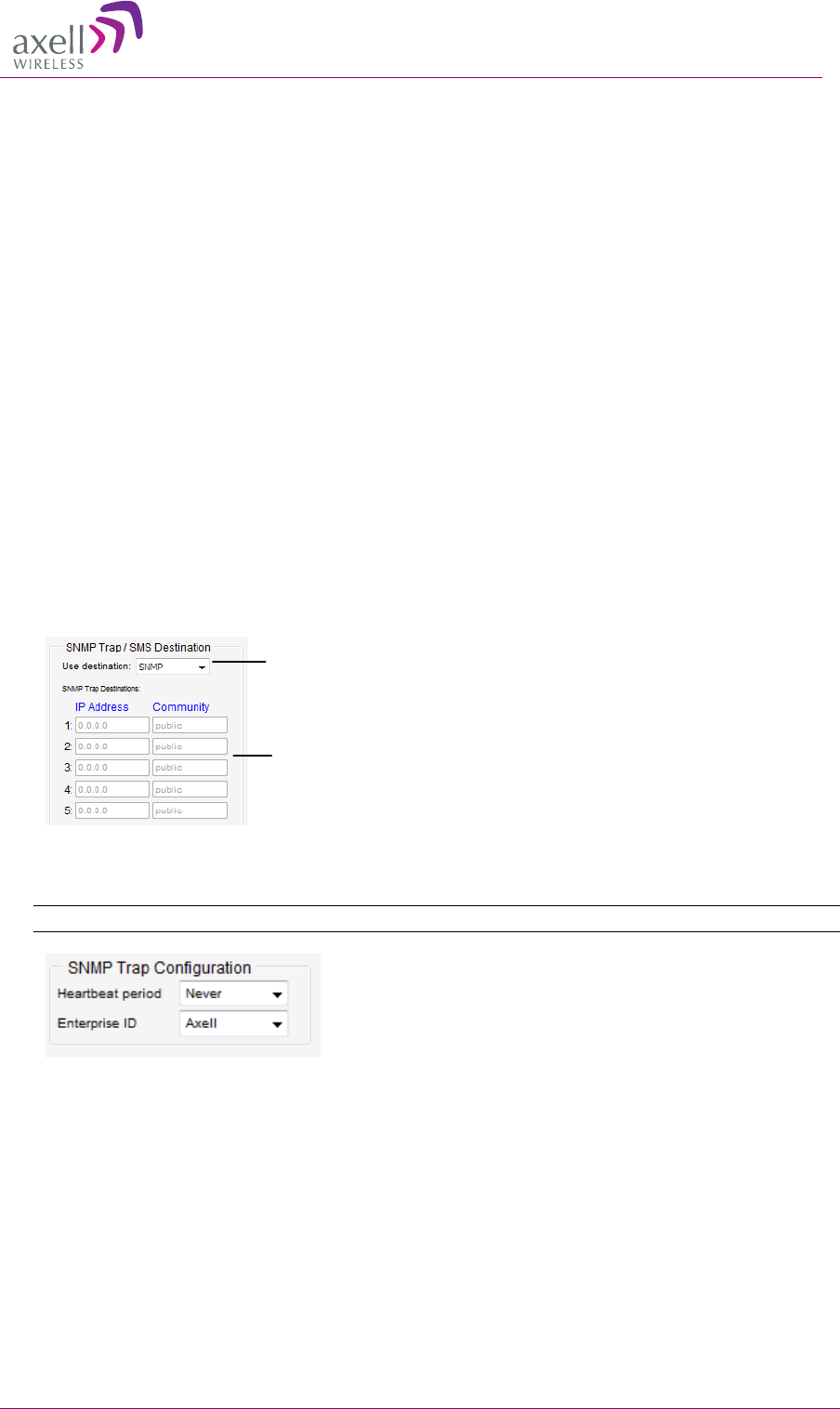
A
XELL
D-MBR-USA
R
EPEATER
PRODUCT DESCRIPTION AND USER’S MANUAL
36 Axell Wireless Ltd
4.8 Configuring Notification Method - SNMP Trap
or SMS
The Repeater can be configured provide fault notification either by sending traps to defined IP
addresses or by sending an SMS message to configured destinations (only one option can be
selected).
4.8.1 Configuring SNMP Trap Destinations
You may configure traps to be sent to five destination addresses each time a fault is triggered. The
traps are sent at the defined heartbeat frequency.
To set SNMP Trap Destination parameters
1. In the Use Destination field, select the SNMP option
2. For each destination:
• Enter the IP Address (where the IP addresses should be in the same subnet as the
repeater).
• Define the Community names (default = public) of the computers to which traps will
be sent.
3. In the SNMP Trap Configuration area, in the Heartbeat Period field, define the frequency (in
minutes) at which traps will be sent.
NOTE: It is recommended to maintain the Enterprise ID as Axell.
4. Click Send.
Select SNMP option from drop-
down list
Define up to five SNMP destination
addresses
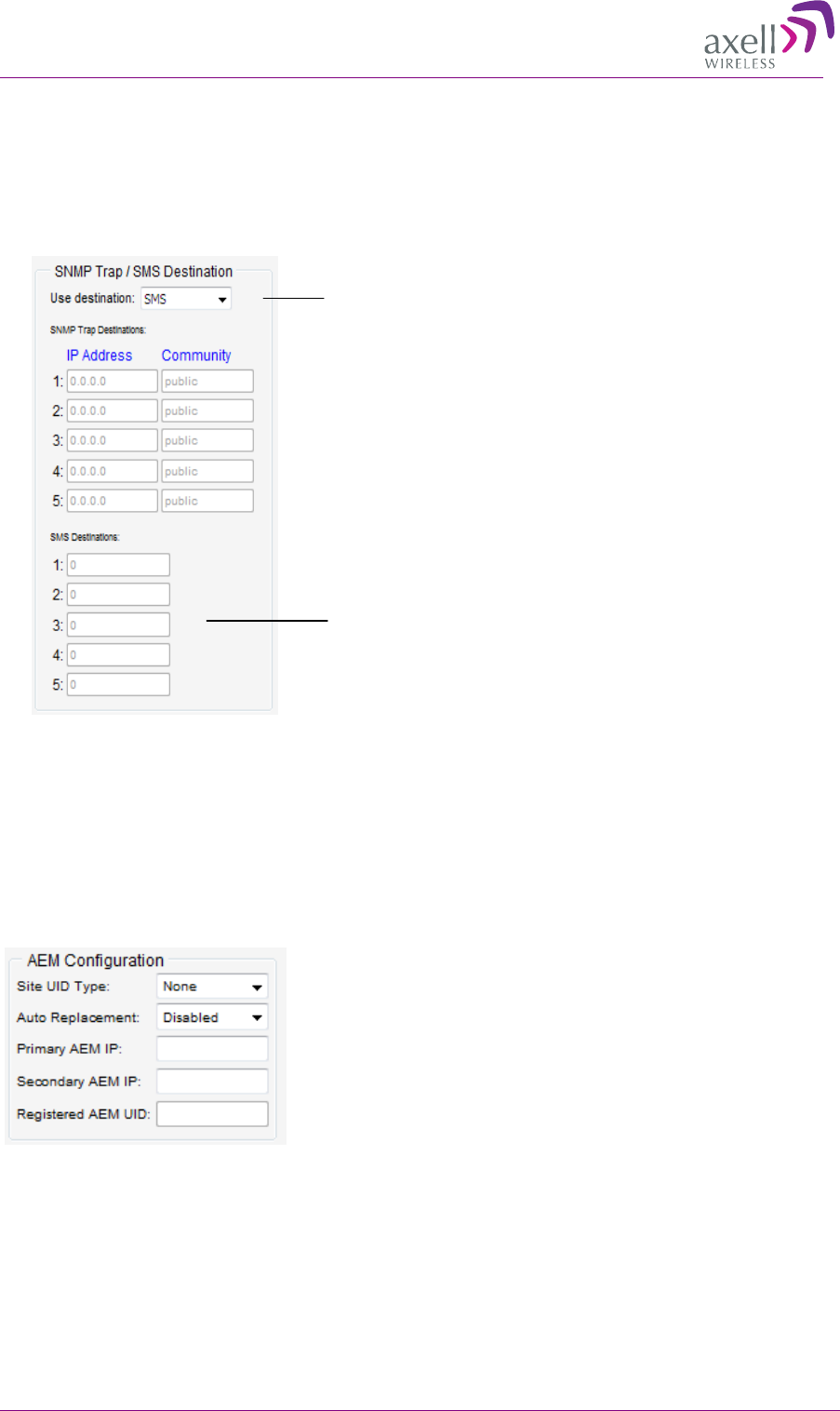
A
XELL
D-MBR-USA
R
EPEATER
PRODUCT DESCRIPTION AND USER’S MANUAL
© Axell Wireless Ltd 37
4.8.2 Configuring SMS Notification Destinations
You may configure up to five SMS destinations (mobile numbers).
To set SMS Destination parameters
1. In the Use Destination field, select the SMS option from drop-down list.
2. Define up to five SMS destinations (for example, + xxx541234567
)
:
3. Click Send.
4.8.3 AEM (Axell Element Manager) Configuration
Configure the AEM parameters provided by the system administrator so that the 3018D Repeater is
integrated in the network and can be centrally managed.
Define the SMS destinations
(mobile numbers)
Select
SMS
option from drop-
down list
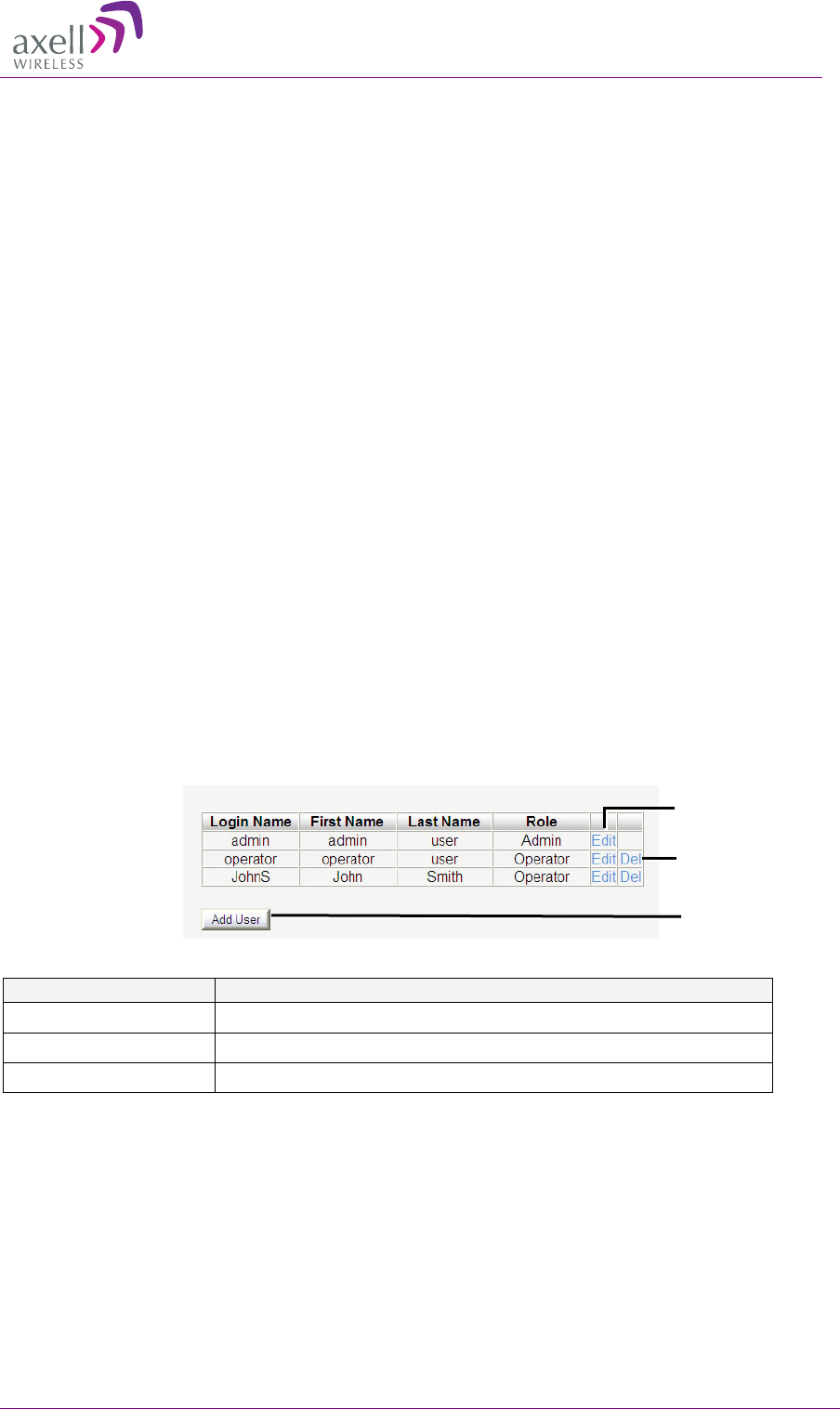
A
XELL
D-MBR-USA
R
EPEATER
PRODUCT DESCRIPTION AND USER’S MANUAL
38 Axell Wireless Ltd
5 Administrative Operations
The following administrative operations are described in this section:
• User Management – defining and changing users and passwords.
• Viewing the Repeater information such as software and hardware versions, serial number, etc.
• Software upgrade
5.1 User Management
This section describes how to perform the user management operations. By default, two users
belonging to one of two authentication levels are defined on the Repeater. You may add new users,
according to one of the available profiles, modify or delete existing users.
5.1.1 User Levels
Two user levels are available:
• Admin – has access to all administration and configuration options, including user management.
(Default Password admin and default User Name admin.)
• Operator – has access to all configuration options except for the Users list or the Loaders screen.
5.1.2 Viewing the List of Defined Users
To display the User Administration pane
From the Tree Pane, select Users. The list of users is displayed in the Configuration Pane according
to the identifying information and authentication level (Role).
The following table provides a description of the Users dialog options.
Option Description
Add User (button) Adds a new user with to user defined access level and password.
Del(ete) Deletes a selected user from the list.
Edit Enables changing the definitions of an existing user.
Edit user
Delete user
Add user
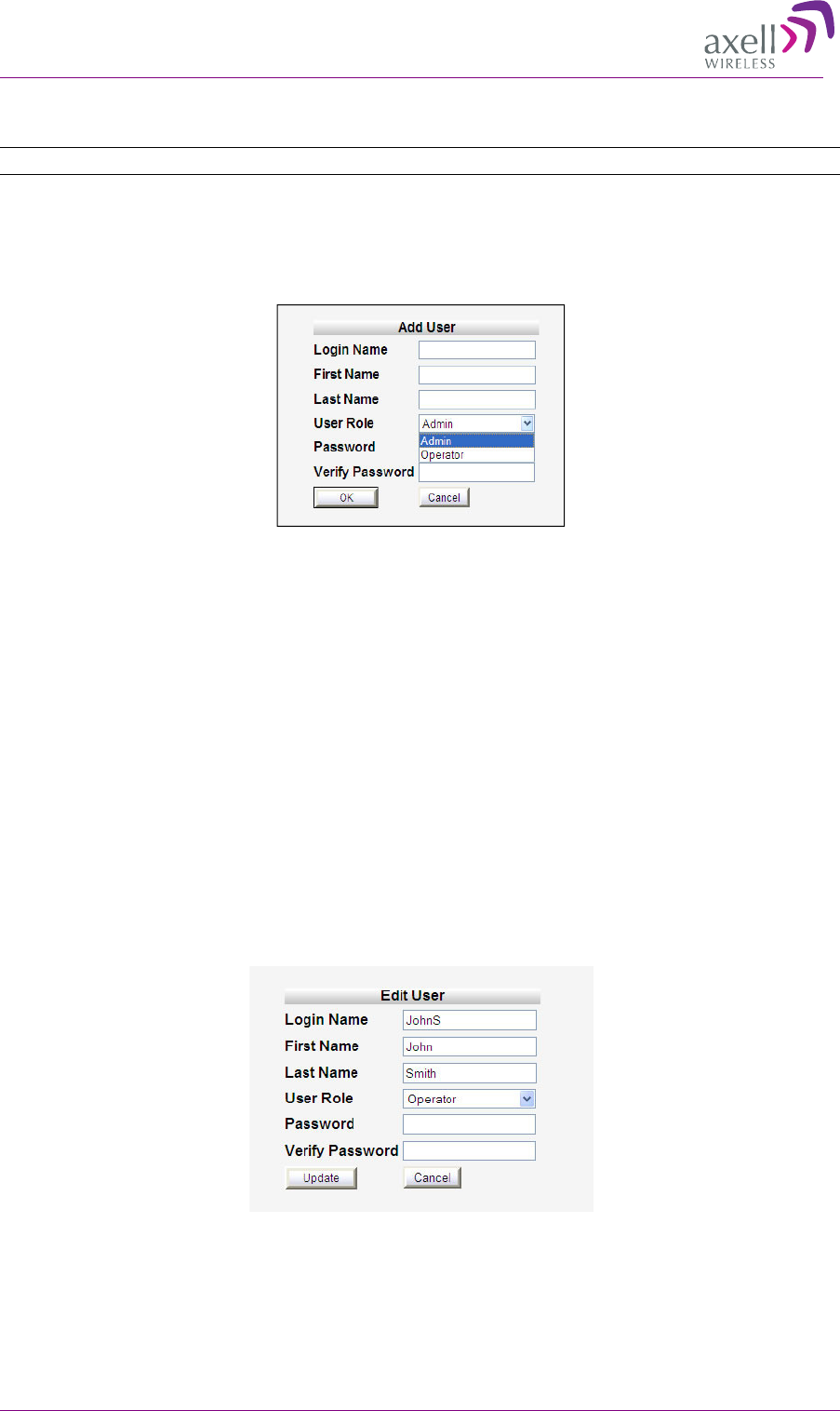
A
XELL
D-MBR-USA
R
EPEATER
PRODUCT DESCRIPTION AND USER’S MANUAL
© Axell Wireless Ltd 39
5.1.3 Adding Users
NOTE: User name and password entries are case sensitive.
To add a user
1. From the Tree Pane, select Users. The list of users is displayed in the User's Pane.
2. From the User's Pane, click Add User. The Add User dialog box is displayed.
3. Enter the Login Name – name used by user to login.
4. Type the user's First Name and Last Name – used to identify the user.
5. Select the User Role – access level. This defines the operations that the user will be able to
perform.
6. Enter the Password and in Verify Password enter the password again for verification.
7. Click OK.
5.1.4 Editing a User
To modify user definitions
1. From the Tree Pane, select Users. The list of users is displayed in the User's Pane.
2. Select the User to be edited in the list.
3. Click Edit. The user definitions dialog appears.
4. Make the required changes and click Update.
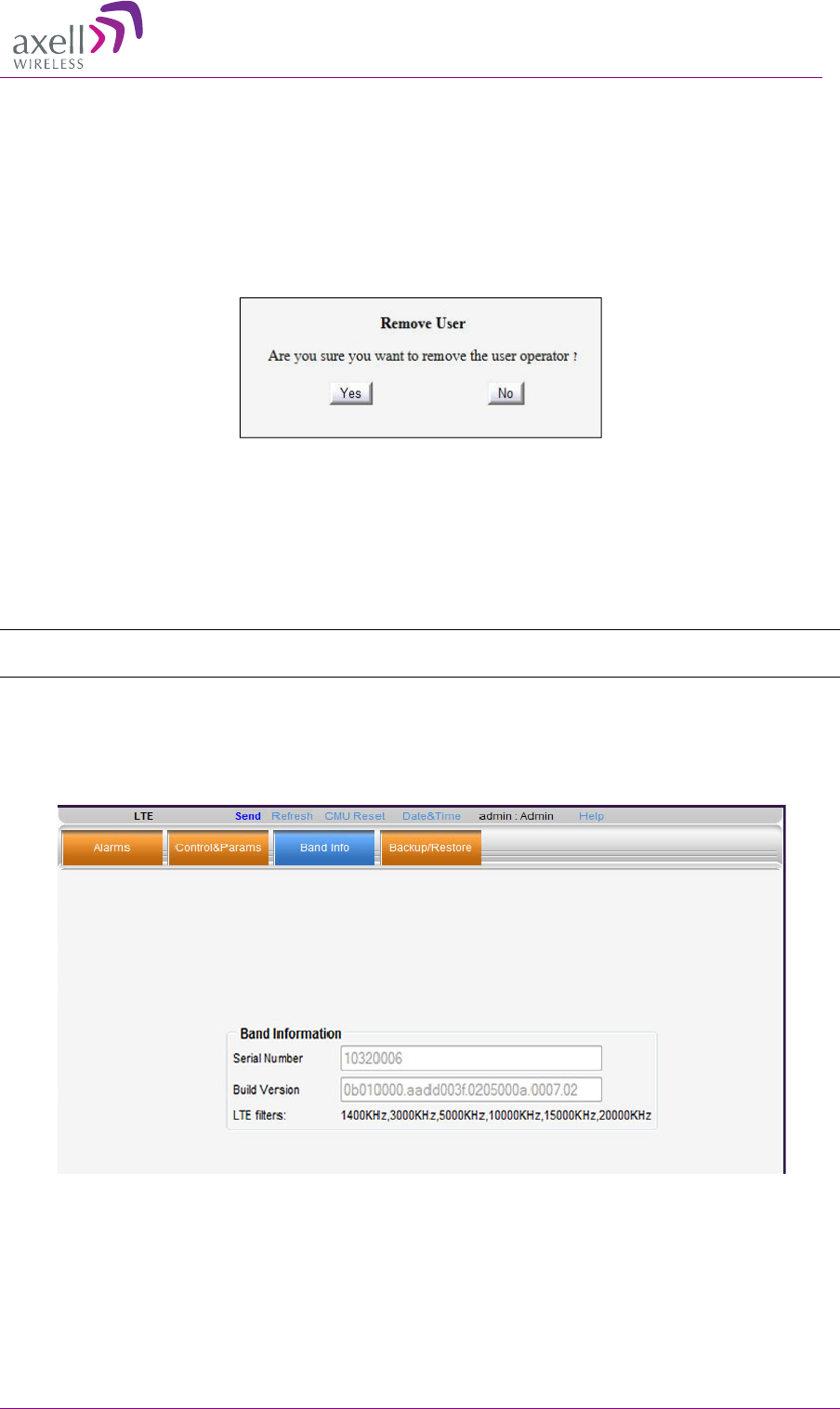
A
XELL
D-MBR-USA
R
EPEATER
PRODUCT DESCRIPTION AND USER’S MANUAL
40 Axell Wireless Ltd
5.1.5 Deleting a User
To delete a user
1. From the Tree Pane Select Users. The list of users is displayed in the User's Pane.
2. Select the User to be deleted in the list.
3. From the User's Pane, click Del. An authorization message dialog box is displayed.
4. Click Yes. The User’s name is removed from the list.
5.2 Viewing Band Information
Use the Band Information screen to view the hardware and software versions of the
D-MBR-USA Repeater.
NOTE: Usually, these fields are grayed-out. Grayed-out fields indicate that the display is Read-only.
Active fields indicate that the parameter values can be defined.
To access the Band Information window
1. From the Tree Pane, select the relevant service.
2. Select the Band Info tab. The relevant parameters are displayed.
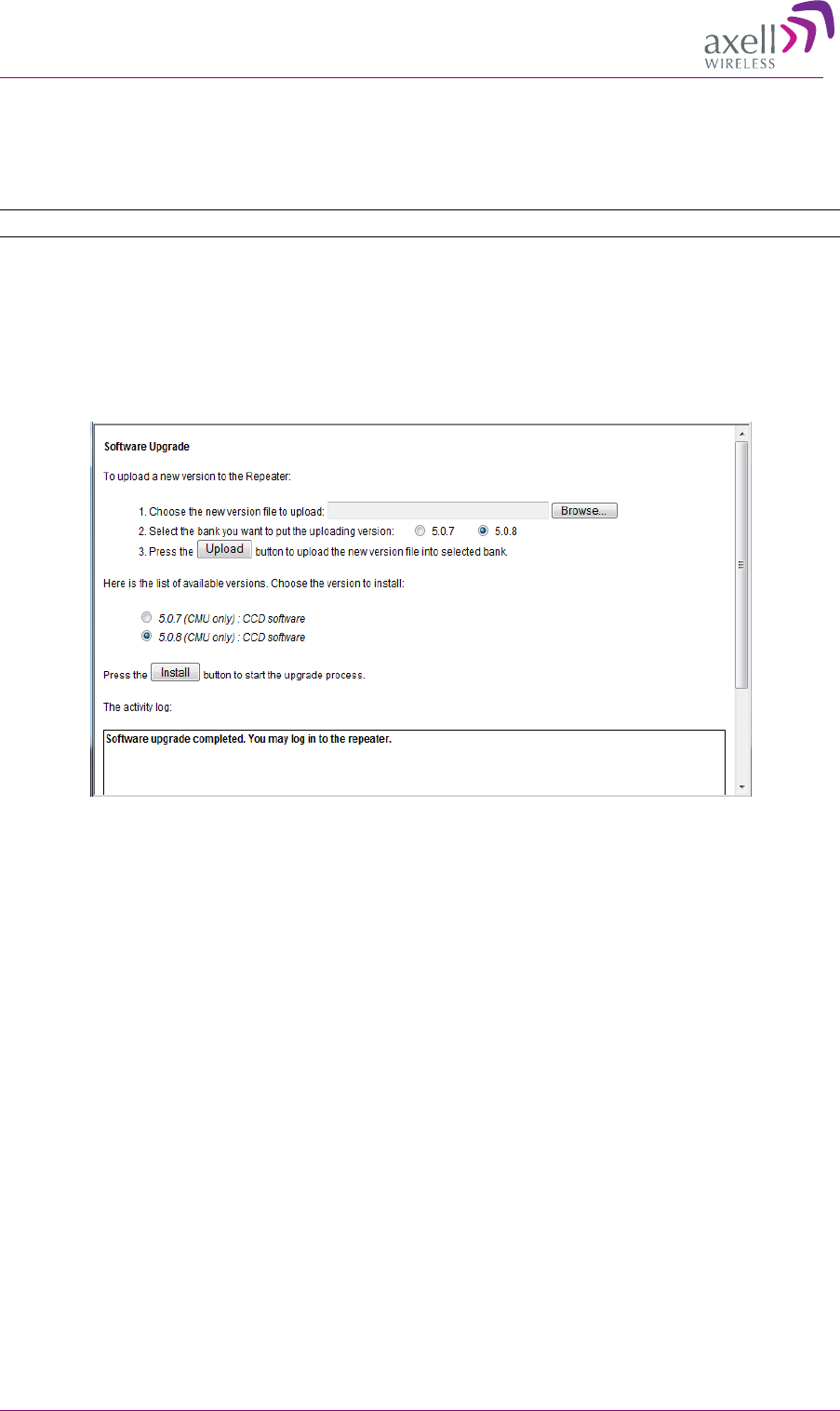
A
XELL
D-MBR-USA
R
EPEATER
PRODUCT DESCRIPTION AND USER’S MANUAL
© Axell Wireless Ltd 41
5.3 CMU Software Upgrade
The procedure described in this section is used to upgrade the repeater CMU.
Note: This procedure is performed for every new management version.
To Upgrade the Repeater SW
1. From the Tree Pane, select CMU.
2. Select the Axell CMU SW Upgrade tab. The CMU SW Upgrade screen shown below appears.
3. Choose the version to upload and perform the procedure according to the instructions in the
screen.

A
XELL
D-MBR-USA
R
EPEATER
PRODUCT DESCRIPTION AND USER’S MANUAL
42 Axell Wireless Ltd
6 Monitoring and Troubleshooting
D-MBR-USA provides an automatic system shutdown and recovery mechanism that is activated
when certain alarms are active. In addition, the repeater provides three types of indications and
troubleshooting tools:
• Alarms screen in Web access application
• Alarms Log – used to view a record of past generated alarms
• Status LEDs on Dual-Band Repeater front panel
The following sections provide a description of the troubleshooting procedures according to the
Repeater LED indicators and the Web access Alarms.
6.1 Shutdown and Recovery Mechanism
The D-MBR-USA shutdown-recovery mechanism mutes the system in the event of specific
alarms generation and re-activates the signal after the alarms are shut off.
The following alarms cause the system to enter the shutdown mode:
• Uplink RSSI.
• Downlink RSSI.
• Detection of oscillation.
• Uplink high output power out of range.
• Downlink high output power out of range.
The system periodically samples the above alarms at 0.5 seconds intervals (by default). If an alarm is
active for nine sequential loops (e.g. 0.5 * 9 = 4.5 seconds), the system will 'shut down' by muting the
PAMP.
When the system is in “Shutdown” mode, the recovery function will periodically sample the alarms
every two hours (by default). If the relevant alarm is no longer active, the system will return to
normal operation mode and reactive the signal.
The sampling and timing mechanisms can be modified by a technician level user.
The shutdown mode can be turned off by the user and the system re-enabled in normal operation
mode by setting RF Transmission Enable to ON.
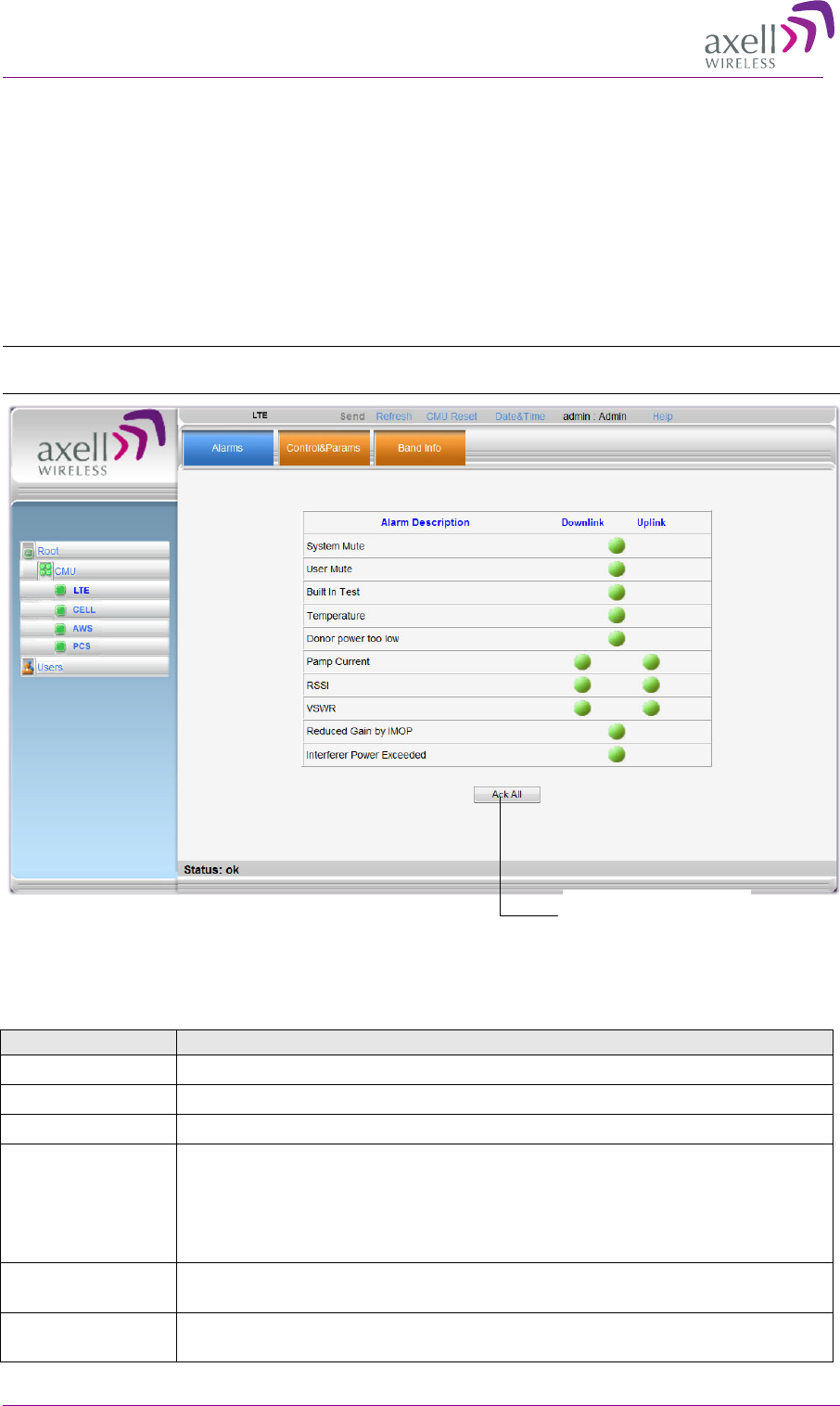
A
XELL
D-MBR-USA
R
EPEATER
PRODUCT DESCRIPTION AND USER’S MANUAL
© Axell Wireless Ltd 43
6.2 Alarms Screen
The Alarms tab provides the alarms generated by the Repeater, enabling the user to monitor the
system operation.
To access the Alarms window
From the Tree Pane, select the band (LTE/CELL/AWS/PCS) and choose the Alarms tab. The
relevant parameters are displayed.
NOTE: The alarm status remains RED once the alarm was triggered. To return the status to normal
operation (Green), click the ACK All button.
Alarm Descriptions
Alarm Fault and most probable cause and Recommendation
System Mute Generates an alarm when Repeater amplification is muted (automatically)
User Mute Repeater amplification is muted (manually) as a result of an operator action.
Built In Test Self test.
Temperature High temperature.
Most probable cause: Unit temperature becomes high.
Excessive heat.
Recommendation: Check the Repeater case for external causes (sun, hot
environment, air flow is blocked). Eliminate the reason for excessive heat
Donor Power Too
Low
The signal from the Donor antenna is too low.
Check connections and antenna position.
PAmp Current
Generates an alarm when the Power exceeds the allowed limits
.
Fault in the DL or UL path.
Click
Ack All
button
to reset the alarms

A
XELL
D-MBR-USA
R
EPEATER
PRODUCT DESCRIPTION AND USER’S MANUAL
44 Axell Wireless Ltd
Alarm Fault and most probable cause and Recommendation
Most probable cause: Downlink (Uplink) power amplifier module outputs a
low current.
Recommendation: Check the LEDs in the Repeater
RSSI Fault in the DL or UL path
Most probable cause: caused by a excessively high input signal
Recommendation: Check the LEDs in the Repeater
VSWR
This alarm is triggered when the return loss of the Downlink antenna or
cable connection exceeds 3 dB (VSWR 6:1).
This alarm provides an indication of the status of the cable connected to
the antenna. If a cable is defective, the VSWR is decreased and the alarm
is triggered.
Reduced Gain by
IMOP
Shows when the IMOP mechanism was activated in order to respond to
detected oscillations.
GREEN – normal operation – no oscillations were detected.
RED – oscillations were detected and the system reduced gain in order to
eliminate the oscillations.
Check the Donor and Mobile antenna installations for isolation. After
isolation is within the required levels, the system will automatically
increase gain (since it will no longer affect oscillations and) and the LED
will turn GREEN.
Interferer Power
Exceeded
Indicates if there is any external interference at a level that may affect the
operation of the unit.
Green – low or no interference. Unit operation is not affected.
Red – high external interference that may affect the operation of the unit. It is
recommended to identify the source of the interference and distance the
source or the unit from each other.
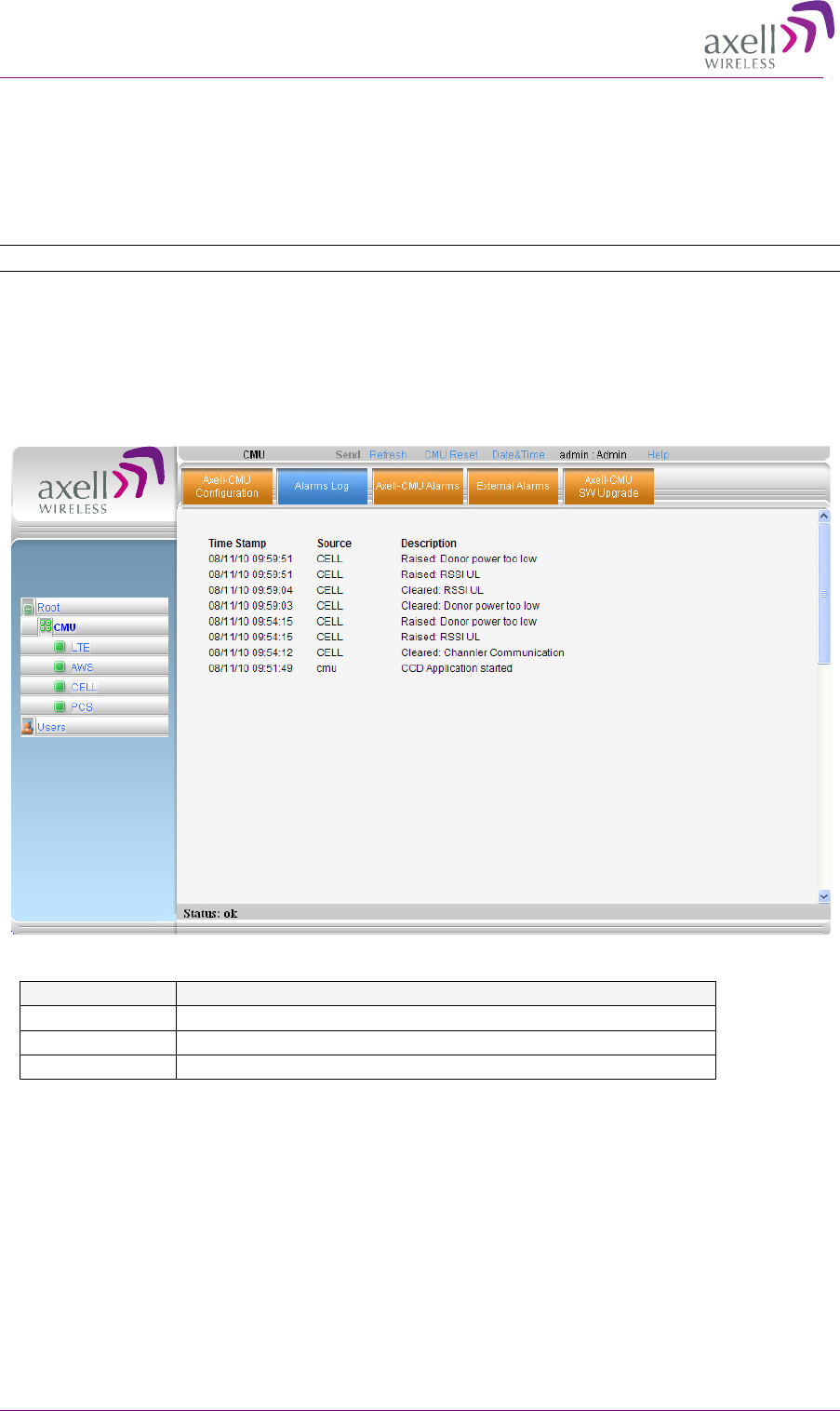
A
XELL
D-MBR-USA
R
EPEATER
PRODUCT DESCRIPTION AND USER’S MANUAL
© Axell Wireless Ltd 45
6.3 Alarms Log
The Alarms Logs screen lists the alarms (events) that have occurred. The CMU maintains log files
listing every alarm triggered and in the Repeater. This screen provides an analysis tool to get
information of any event that has occurred, its originator, when, if they return, and their type.
Note: Set the clock in order to synchronize the events time of occurrence. Click on Date & Time.
To view the CMU log screen:
1. Open and login to the Web application.
2. From the Tree Pane, select CMU.
3. Click Alarms Logs. CMU displays the Alarms Log Table.
The following figure provides an example of the Alarms Log.
Item Description
Time Stamp The date and time the alarm was created
Source ID of Network Element
Description Description of event that caused the alarm

A
XELL
D-MBR-USA
R
EPEATER
PRODUCT DESCRIPTION AND USER’S MANUAL
46 Axell Wireless Ltd
6.4 D-MBR-USA Front Panel LED Troubleshooting
The D-MBR-USA Repeater includes LED indicators for each supported band on its front panel (see
1.4) in addition to the two Ethernet LEDs. The following table provides a description of the Service
and Ethernet LED statuses and troubleshooting procedures.
LED Color Status and Probable
Cause
Recommendation
Service Green Normal operation -
Red Major error The Repeater must be replaced
Blinking
Orange/red
User mute
System mute
- Due to isolation problem
or temperature
Check gain of repeater. If gain is
minimum, then it is likely an isolation
problem -> improve the isolation.
Reset the Repeater by turning if off
and on again. If the fault continues,
replace the unit.
CCD Blinking Green System initiating -
MDM Steady Green Modem isn’t defined or
modem operating
normally.
Blinking Green Modem is trying to
connect.
Steady Red Modem is trying to
connect

A
XELL
D-MBR-USA
R
EPEATER
PRODUCT DESCRIPTION AND USER’S MANUAL
© Axell Wireless Ltd 47
Appendix A: Specifications
RF Per Band
Parameters DL UL
LTE
700 MHz
CELL
850 MHz
AWS
1700
MHz
PCS 1900
MHz
LTE
700 MHz
CELL
850 MHz
AWS
1700 MHz
PCS 1900
MHz
*Frequency
Range
(MHz)
L
7
28
-
7
46
869-894 2210-
2155
1930-
1990
L
698
-
716
824-849 1710-1755 1850-1910
U
746
-
757
- - - U
776
-
787
- - -
Selectable
Blocks
Up to 8 or 12 sub-bands model dependent
Passband
Gain (max)
82 dB
Passband
Ripple
± 2.5 dB
Gain
Attenuation
(1dB steps)
0-25 dB
Composite
Output
Power
+ 33dBm +33dBm +30dBm +30dBm +27dBm +27dBm +27dBm +27dBm
Propagation
Delay
< 6 µsec
* U – Upper LTE frequency; L – Lower LTE Frequency
**700 - all LTE filters 1.4/3/5/10/15/20 MHz; Cellular A , A' , A'', B, B' , up to 25MHz in 2.5MHz steps and all LTE filters;
AWS up to 20Mhz in 2.5Mhz steps and all LTE filters; PCS up to 20Mhz in 2.5Mhz steps and all LTE filters
Power Supply
Parameter Description
Power Supply 110/240 VAC
Power Consumption Max 320W for 3 bands, Max 400W for 4 bands
Total RF Input Power (No Damage) + 10 dBm
Impedance Level 50 Ohm
V.SW.R 1.5:1
Mechanical Specifications
Parameter Description
Size B x H x D 450 mm x 225 x 500 mm (19” x 5U x 19.7”)
Weight 77 lbs(35Kg) for 3 bands, 86 lbs (39Kg) for 4 bands
Environmental Specifications
The Repeater is designed for indoor installation.
Parameter Description
Environmental conditions Indoor, forced cooling
Operating temperature -10 to +50
°
C (14 to 122
°
F)
Storage temperature -40 to +85
°
C (-40 to +185
°
F)
Humidity 85%
MTBF, Complete System > 70 000 hrs.

A
XELL
D-MBR-USA
R
EPEATER
PRODUCT DESCRIPTION AND USER’S MANUAL
48 Axell Wireless Ltd
Connectors
Connector Type
RF Connectors: Base/Mobile N-Type, Female
Communications RJ-45
Coupling Connectors (-30dB) Base/Mobile SMA Female
Alarms - optional Dry Contacts – 8 pins (See section 3.11)
Normally Closed (NC); Common; Normally Open (NO)
(*) All parameters are typical @ +25ºC